CCC – The Not-So-Little Sister Race of the Legendary Ultra-Trail du Mont-Blanc
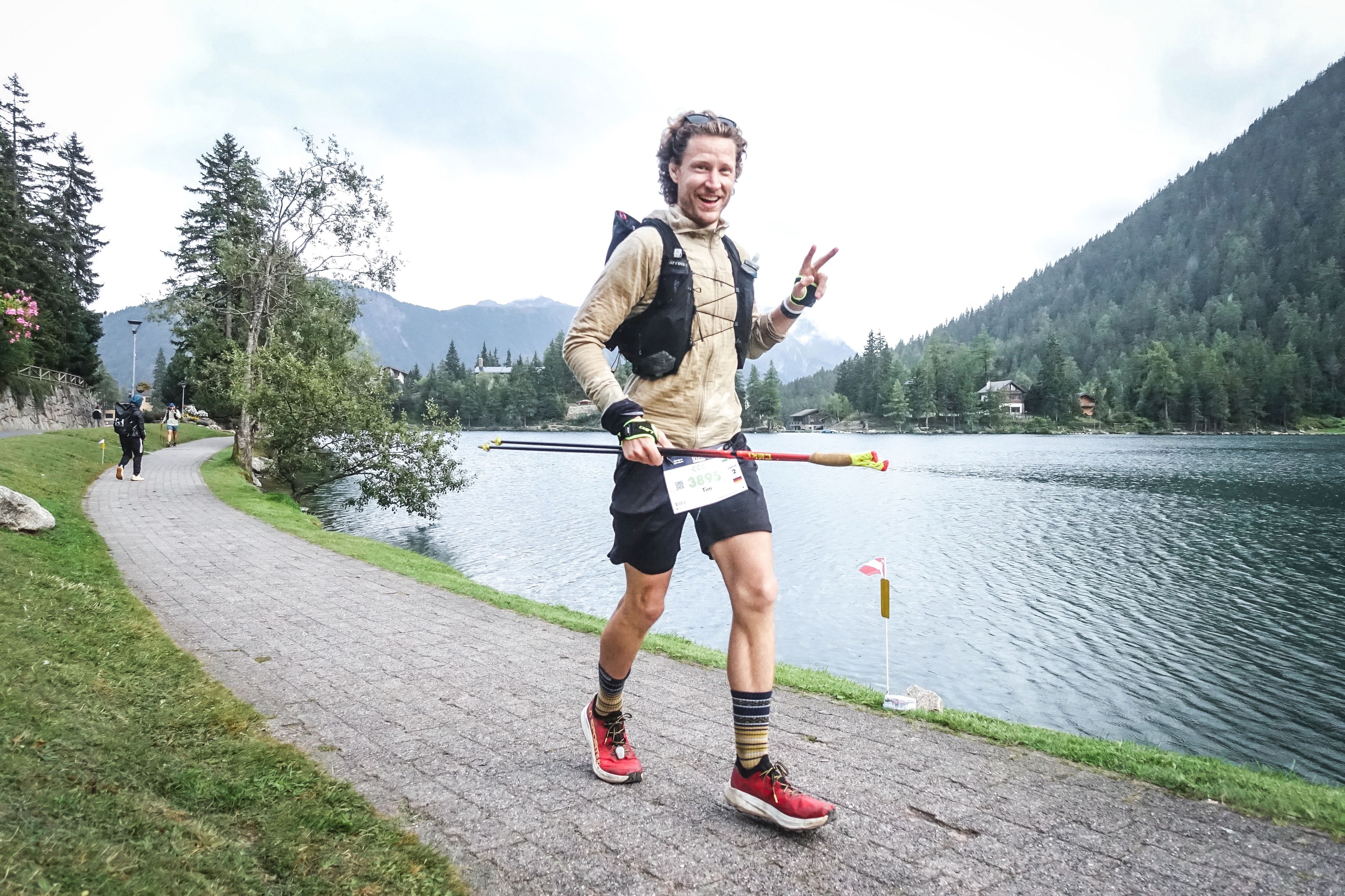
With a length of 101 kilometers and about 6,100 meters of climbing, this race around the Mont Blanc massif demands every ounce of effort. Is it worth it?
Courmayeur → Champex-Lac → Chamonix. The CCC is named after the three major towns involved in the route. Each town marks a chapter in the journey, with the route carrying runners across 🇮🇹 Italy, 🇨🇭 Switzerland, and finally into 🇫🇷 France.
This is the story of my 2025 participation in this race. It is a story of extremes, because given the size and history, as well as notoriety of this event and the company behind it, there is nothing average about it. And coincidentally this has also been my personal race experience. It has been both absolutely amazing and relentlessly punishing, with close to nothing in between.
“Spare no detail!” I hear you say? No problem!
The Ultra-Trail du Mont-Blanc, or UTMB for short, started in 2003 as a foot race around the whole Mont Blanc massif. Back then, it was about 150 kilometers long but has since settled on a length of a bit over 170 kilometers (105mi) with nearly 10,000 meters (33,000ft) of elevation gain. It’s a brutal race, which is why the folks who came up with the idea were smart enough to include shorter distance races as more inclusive options for other keen runners right from the beginning. Now, the CCC race consists of basically the last one hundred kilometers of the 170 kilometer long UTMB, with a few very small detours. It’s a great way to get to know the feel of the long loop.
🎭 UTMB – A Race and a Company of Extremes
The event has had huge gains in popularity over these past 23 years and today is quite certainly the biggest and best-known ultra trail race in the world. The magnificent region in the French Alps, the status of Mont Blanc as being the tallest mountain in Western Europe, and the trail running affinity of the hosting towns, not to forget the culinary culture and hospitality of both country and region, have made it a bucket list race for runners from all over the world.
However, this success hasn’t come without its scandals, problems, and bad publicity. Some very renowned elite ultra trail runners, including former UTMB winner and all around respected ultra running legend Kilian Jornet, have publicly spoken out against some central aspects of UTMB business practices.
The race has become a company, the UTMB Group, and has seemed to aim for global dominance of the whole trail running community as well as profit-maximization above all else. Internationally, races get “bought” and re-branded as “by UTMB”, entry fees hiked up, volunteers siphoned away and smaller local races are hurt in the process. The UTMB Group even tried to trademark the term “Ultra-Trail” – which is so ridiculous, it would be as if Coke would try to trademark production of fizzy and sweet drinks in general. Fortunately, that trademark claim was dropped later.
Still, the simple and nature-connected trail running ethos doesn’t align well with this multi-national mega conglomerate it has become. A large carmaker is the new title sponsor, and the UTMB Group is ultimately owned by Advance Publications, a multi-billion dollar media holding organization with tens of thousands of employees in dozens of countries worldwide.
So while some conscious runners have a problem with these aspects, not everyone knows or wants to know how the sausage gets made. We’re just human, after all. We fly planes and eat meat even though we know it’s bad, we smoke and drink and overeat, we do lots of stupid stuff. I don’t think anyone is exempt from that – I’m certainly not. But everyone seems to have set their own boundaries somewhere.
For me, an ultra trail running enthusiast, it has long been hard to come to a decision regarding ever racing UTMB or a shorter race during the week in Chamonix. What made the difference in the end was just how exciting it’s been to watch the excellent livestream for the past few years. To get to feel the energy of the Chamonix crowds, the Vallorcine aid station craziness, to listen to that Vangelis title song over and over again, see the people crying at the finish line, be in awe of how incredibly good the elite runners navigate those tough trails, enjoy the wonderful drone footage of the mountains, and just sort of feel the spirit for close to a full weekend – since even the pros need around twenty hours to complete the grueling major event, the 170 kilometer UTMB race.
🎟️ The Qualification Process
If you’ve followed my journey, you know I’ve been in the process of trying to get to start at the Western States 100 Endurance Run for quite a few years now. For most people trying the same thing, it takes about ten years until that finally leads to success. That’s mostly due to the fact that the Western States only allows 369 runners to take part in its annual event – for environmental reasons. The UTMB doesn’t have those restrictions to navigate, but that’s a blessing and a curse. The participation numbers of each of the different races here are well into the thousands. In the CCC alone, we had over 2,000 runners starting in Courmayeur. This leads to very congested single-trails for actual dozens of kilometers in the beginning.
You might think that makes it easy to get a ticket for the race, but you couldn’t be more wrong. The trail running community in Central Europe is just so strong and determined, even the very first edition back in 2003 was fully booked – nearly twice over!
These days, a qualification system requires you to run several other races of the “by UTMB” brand to collect so-called Running Stones, a virtual currency created to help improve your odds at being selected in a lottery with very little transparency. That’s another thing that doesn’t bode well with the greater trail running community: Runners who are eying a UTMB participation at some point in the future will now have to basically exclusively do these UTMB-branded races, because all other smaller and independent races just aren’t allowed to hand out the coveted Running Stones. The Western States system, on the other hand, is more open in that regard.
Depending on the difficulty of the UTMB-branded race you participate in, you’ll receive either 1, 2, 3, or 4 Running Stones added to your account. Roughly speaking, those tiers represent 20k, 50k, 100k, and 100 mile races, respectively – but they all are hilly trail races with lots of elevation.
Without really meaning to, my main quest for making it to the Western States one day has led me to accumulate 7 Running Stones.
The races I’ve done just happened to hand out the stones. So when UTMB lottery season came around and I received the email reminding us to throw our names into the hat, it was a half-surprise to me that I would have an actual chance of getting pulled. And that’s the moment I thought I might as well give it a try. All the bad stuff about UTMB lost in importance when I encountered this exciting and gamified opportunity to go to Chamonix for the first time and see it all from my own personal perspective. Talk about making a moral compromise.
There was just one decision to make: The full UTMB or the shorter CCC? It didn’t take me long to decide, though. I haven’t done a 100 mile race yet, especially not one containing 10,000 meters of vertical gain. My personal best in that regard was the grueling Lavaredo Ultra Trail with its 120 kilometers and 5,800 meters of gain. I know how brutal the UTMB race is and I didn’t feel ready. Even though the CCC represents a vertical gain personal record for me as well, on paper I’ve completed harder races, Lavaredo being one example.
I threw my name into the CCC hat and got pretty excited in the days after. When I then actually received the YES, YOU’RE IN! message, I was absolutely hyped. The center of the trail running world, and I’ll be right in the middle of it soon!
🎉 Chamonix! Let’s do this!!!
My personal timing couldn’t have been much better as well. With an early-in-the-year Western States qualifier already completed at Tuscany Crossing, I wouldn’t even have any pressure at CCC which is itself a Western States qualifier race with a time limit of 25 hours to finish. The race is at the end of August, very late in the season, which makes it a final celebration of the year. Triathlon season is over as well, so I wouldn’t have to split training between disciplines. And as I usually keep a bit more active and focused over the summer, I’ll probably bring a good chunk of physical fitness to Chamonix.
This all turned out to be true.
📋 My Focused CCC Training Regiment
With a fresh personal city marathon best of 2:55h back in March and a bunch of other fast results at shorter races, I felt my speed was strong enough. The main challenge is the elevation and my weak ability to do technical downhills fast. Both of it is hard to train for in flat northern Germany where I live, but there are options to get prepared if you look for them.
Eating lots of kilometers also obviously helps, regardless of the elevation profiles. After triathlon season was over for me, I had around six weeks to go until CCC. I decided to get into a weekly groove that looked roughly like the following.
- Going for 100 to 130 kilometers per week total, as time allows (60-80mi)
- One elevation-centric longer run early in the week – moving from 500m up to 1,000m of gain over the weeks, usually about 18-30 kilometers in length (1,500-3,000ft on 12-18mi)
- One big long run on the weekends, moving from 35 to 55 kilometers maximum (20-35mi)
- A virtual bike ride on Zwift, either focusing on short VO₂max efforts or on massive elevation gain for improving leg strength over prolonged periods
- And, since I’m still on my run streak, filling all the remaining days with a random number of kilometers I felt like doing
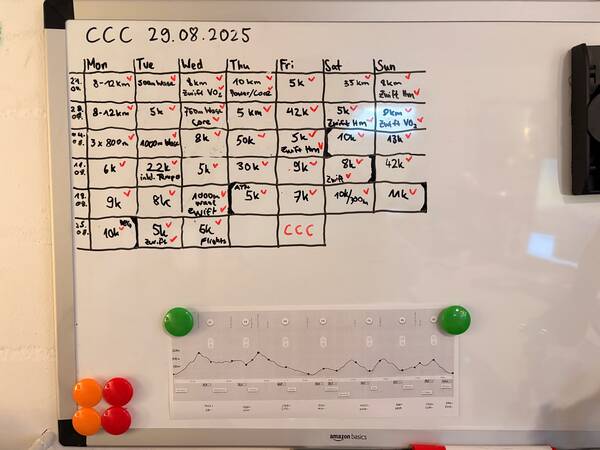
Of course, some gear checks were also needed, such as practice with my running poles or the type of gels I planned on consuming during the race.
The CCC race date at the end of August also meant that the six weeks before it were our summer holidays. With four children and a working wife, it was chaotic. We did a trip to Denmark, which was great but further eliminated any elevation training options for me, and the kids went on separate trips with friends. Shortly before leaving for Chamonix, my oldest daughter and I went on an amazing cultural trip to Athens, Greece – the 35C (95F) weather providing me with some heat-training opportunities, but the airline left us stranded on the way back in Belgrade, Serbia, of all places. A lot of intentional and unintentional time spent at airports and in planes made me develop an annoying cold just days before the CCC. I got anxious. Running such a race while sick would just be bad.
I have been in the situation a few times before, and it’s always very important to listen to your bodily signs. A cough, snotty nose, and one inflamed inner ear weren’t great, but it’s usually still possible to run without seriously jeopardizing your health. It depends on the intensity, of course, and I was glad it’s a low heart rate ultra trail instead of a max effort half marathon I was planning on completing.
My wife Sophie managed to get some additional vacation days from her job and my parents offered to move into our house to take care of the four daughters while the two of us spend a prolonged couple’s weekend in France. I’m very thankful for all the help.
🧳 The Journey to Chamonix
We flew down because it just takes too much time to drive or go by train from Hamburg. At the baggage claim of the closest airport, Geneva, we were already joined by lots of others coming from far away to go to Chamonix. Next to me stood a man from Norway and one from Colorado, both also signed up for the CCC. The Colorado guy carried his Western States backpack – the first person I met in person who actually ran that race! We had a chat, of course. His wife claimed that even just crewing for the Western States was epic.
I did an embarrassing faux-pas though. I was wearing a shirt with the Leadville 100 logo on it. That’s a 100 miler in Colorado not many Europeans have done. I’ve not done the race either, but got the shirt from a friend who visited the place – it doesn’t say “Finisher” on it, but I guess it’s sort of implied. It wasn’t ever my intention of coming across as a finisher of that epic race, just as a fan. No one ever noticed the shirt before, but here I’ve come to the wrong place. The Colorado guy said he’s done the race twice and lives close by. He asked about my finishing time at Leadville.
🫣 “It’s time for a confession, …” I replied. We then laughed about it, but I preferred not to wear the shirt for the rest of the trip.
A few delays during our flight connection had made me anxious about actually receiving my checked baggage in Geneva, as it contains some racing equipment I wouldn’t have wanted to miss out on. An example being my running poles. I had the essentials in my carry-on, as always, but the poles weren’t allowed in the cabin as I understood it. They could sort of be used as weapons, I guess. The Norwegian guy next to us told me that he always flies with his poles in the carry-on bag and encountered no problems so far. Interesting!
The vast and wonderful world of air travel.
Thankfully, my bag survived the trip and appeared shortly after on the belt. I wouldn’t have wanted to restock the twenty gels I had in it at the last minute either.
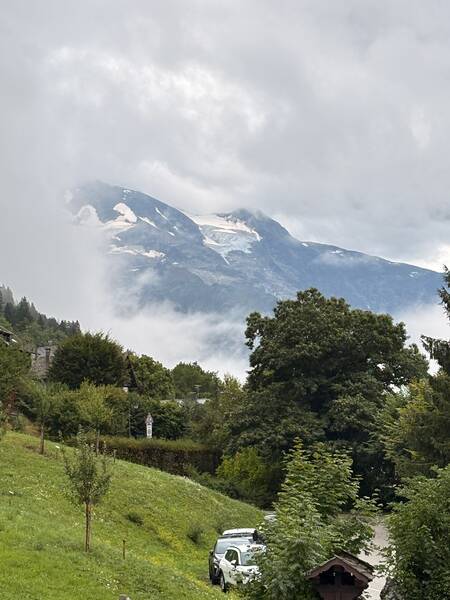
🪄 The Magic of Chamonix
Again mentioning the Western States 100 now, where not only the starting line town of Olympic Valley, but also the finish line town of Auburn in California have both branded themselves “The Endurance Capital of the World” in an unsurprisingly American fashion of exaggeration, the title would definitely make more sense when describing Chamonix. The event size alone eclipses any American endurance event a few times over, even including Kona, Hawaii, where the triathlon world championships are located. I don’t think this has to be a competition, though. Any size event is good to me when done well and in service of the people instead of the financial company stakeholders.
I certainly was skeptical coming into town. Will this be a ten euro per cup of coffee experience, so full of people you can’t even move? Do I even want to spend time here in the town center, is it worth it?
✨ But in short, yes. It was amazing.
It’s full, no doubt. But that didn’t seem to hurt the event just yet. People were friendly and happy. The proud French people even spoke English and were not annoyed or dismissive when we tried our very basic knowledge of the French language on them! They gave us the impression that we were very welcome in town. With so many fit and healthy runners around me, I felt in good company as well. I usually don’t like the group dynamics that can occur when like-minded folks gather, but here it didn’t seem to be bad at all. No drunks or loud annoying folks, everyone is just here to have a good time, eat all the carbs, and check out the vast amount of cool gear presented at the expo.
It was a very international and respectful celebration of the sport. There’s been a public viewing spot where we could watch the livestream showing Jim Walmsley spectacularly winning the 56k OCC race on Thursday and then see him in person crossing the line right here in town. I was actually star-struck. So cool standing in the vicinity of the Western States course record holder and UTMB champion of 2023!
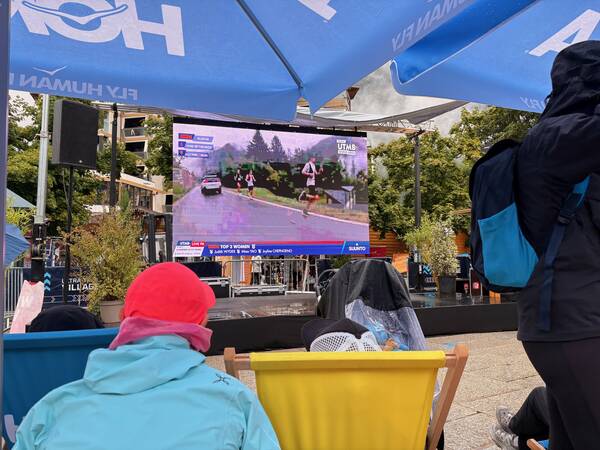

The announcer switched between French and English while managing to keep it pleasant – a rare talent.
🛍️ Money Flying Out of My Pockets
The expo itself was my happy-place. It seemed that every single company that plays a role in trail running gear had set up their booth here. I couldn’t tell you who was missing – with one exception, the MNSTRY nutrition guys. I wrote to them beforehand and they replied they might come at some point in the future. Other than that, it was just amazing to stroll through here. I’m a sucker for great gear, it makes all the difference to me.
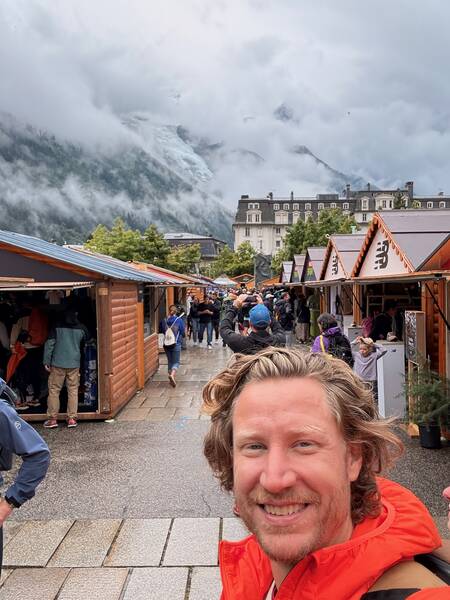
The weather predictions changed for race day, it was expected to get colder. Today, the day before the race, we had 10-15C weather (50-60F) with cloudy skies and occasional rain, but it wasn’t much. On the peaks of the route it was supposed to get below freezing, though, which is why the race organizers sent out a mass text saying that the mandatory gear kit now has to include cold weather clothing items, too. Coincidentally, I had stupidly forgotten to pack my warm fleece layers, so some shopping was necessary. But if this wasn’t the right place to do just that, I don’t know what would. I took the chance to upgrade from fleece to real Merino wool – and what a difference that made!
Before traveling here, I knew that a bunch of people I knew from the trail community and other sports events would go to Chamonix, too, and I was looking around to spot some, but no luck. I think it’s just too big an event for that to happen randomly. I walked past Karel Sabbe twice, though – the FKT King and Barkley Marathons finisher #17. He ended up finishing strongly at the long UTMB this weekend.
When Sophie and I walked through the main shoe sponsor HOKA’s building at the expo, I checked out the new Mafate 5 trail shoe and asked a lady working there some questions. She answered and then said in German: “Hey, aren’t you Tim from BremenSanktPauli?” – it was Elke, finally someone I knew! I had no idea she was working for HOKA and that she would be here.
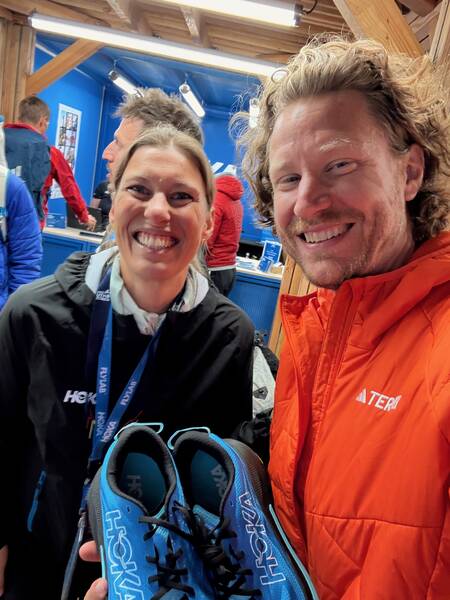
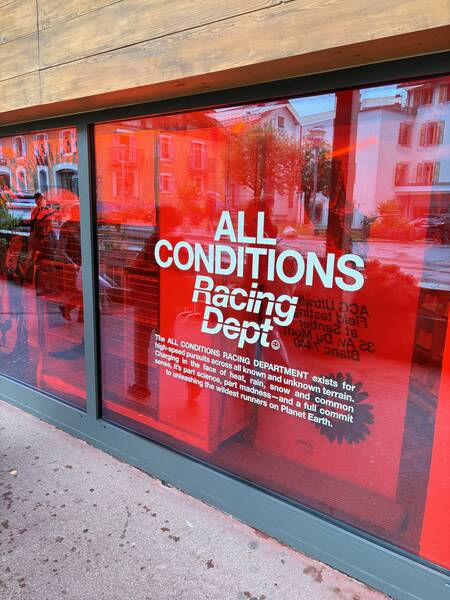
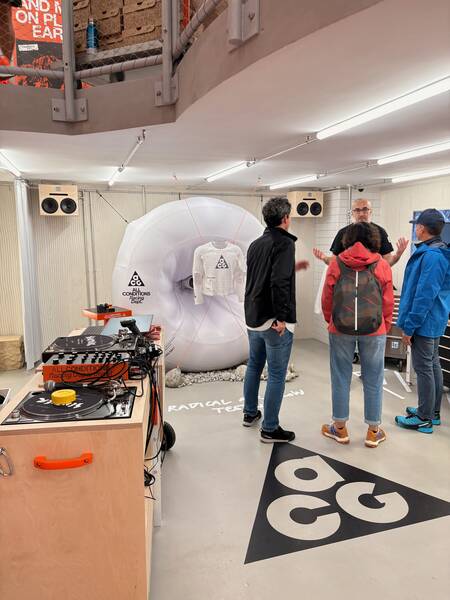
🔍 Taking Care of Business
I’m not here just to hang out at the expo, although that would be cool, no, I have a job to do. One hundred kilometer races don’t work well without a bib number, so the check-in is next. Because of the huge number of participants we had to each book a specific two hour time-slot for a day of the race week in the months before, which was actually great because it reduced waiting times for us now. Everything was checked, I received one of those bracelet-like bands identifying me as a CCC runner, and I had to present my race gear bag which would get a transponder chip, too. Nearly everyone had to go through a mandatory race gear check as well, but I somehow got around that. It doesn’t matter, I wasn’t trying to cheat – I had everything ready that the long list required. Being a gear-nerd, that’s a given.
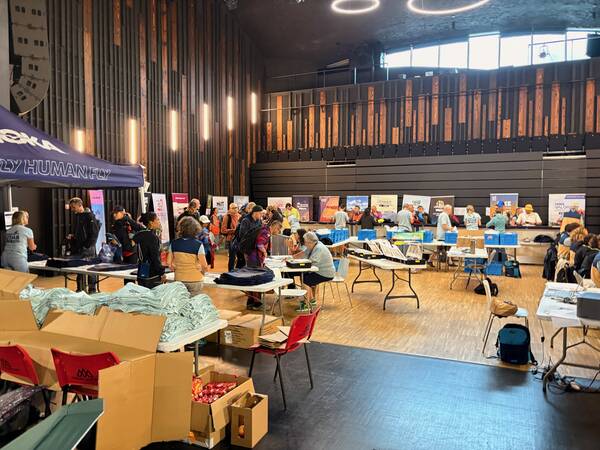
They hand you a free shirt and bag. Well, only sort of free, since you’ve paid good money for the entry. Afterwards everyone gets photographed holding their race bib numbers. We are then personally briefed by volunteers so we are aware of some special signage to expect during the race. Those signs include: “Careful, cattle herding going on in this area”, “Please dial your headlights down in this area“, “No poles zone“, “Don’t deviate from the route at all here“, “Please close the pen behind you”. The signs are easily readable and well-illustrated, so I don’t think any explanation was necessary. But I guess it’s better to be safe than sorry.
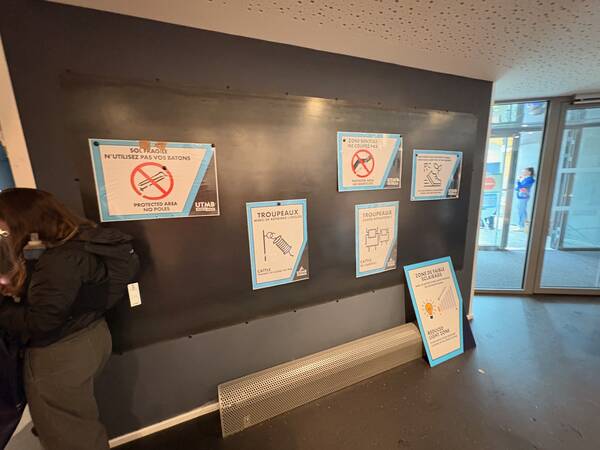
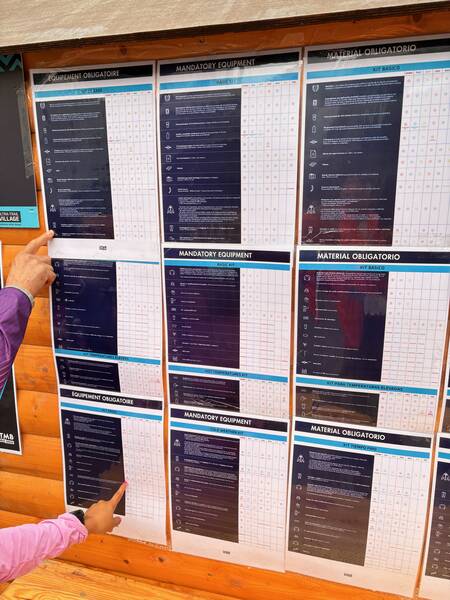

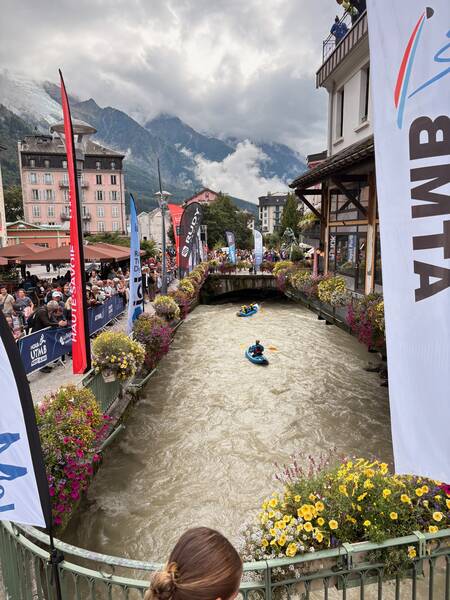
It’s a bit of a circus vibe, but I’m not complaining. Just to present you with all the details – because that’s what I do here – this year, the entry fee was 285 euros (330 USD), quite on the heavy side. The reasons are well documented above. I’m sure the level of service could have been pulled off with 20-30 percent less of a fee. But since people are willing to pay the high amount, and that clearly includes me, I guess we’re the ones partly to blame for it coming to this.
With that being done, the pre-raceday excitement just had to be converted into some more individual planning: What to put into my race bag next to the mandatory gear, what to put into the other bag for Sophie to bring to the later aid stations; and then the day needed to conclude with a good and large meal. A vegetarian pizza sounded like a good option to me, so with a satisfied and relaxed body I went to sleep early.
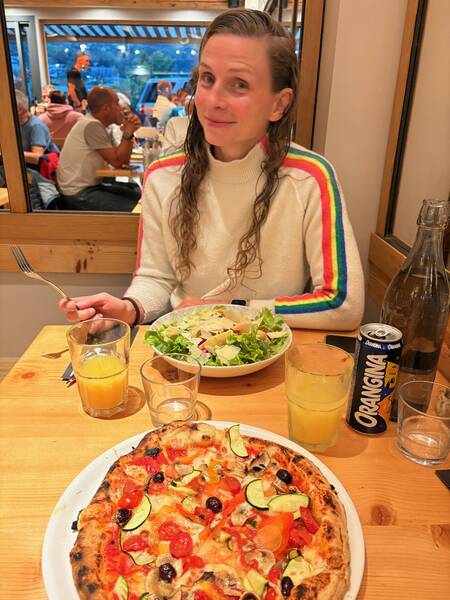
🎒 Intermission: My Gear List
Over the years I have found out mostly through trial and error what an important role proper gear can play. For posterity and your information, here are the main items I’ve settled on for now. Let’s start with the most important one, the shoes. With one little exception nothing on this list is sponsored, and I’ll mention the exception.
👟 La Sportiva Prodigio Pro
A bad choice here can make all the difference, as I experienced during my one and only ultra trail DNF back in 2022 at Templiers. What makes a shoe perfect is how well suited it is to the specific race. I’ve tried many different brands over the years – the big players as well as the nerdy niche ones, and I’ve learned that I don’t need lots of cushioning for trail ultras. I do appreciate a wide toe box, and a very grippy outer sole, because I’m not the most confident alpine downhill runner. Also, I have giant feet, size 49 in the EU or 14 in the US, and on technical segments my feet shouldn’t get in the way of themselves, so a big shoe with lots of material and stability to all sides is just too much.
The Prodigio Pro ticks all the boxes for me. It was perfect for the CCC and I have absolutely no regrets choosing it. I think it’s even quite versatile – a flatter ultra with rolling hills should have worked well with it, too. It certainly worked well during my not-so-technical training runs here in flat Hamburg. Not only that, I was surprised at how well the shoe protected me from the wet conditions and especially the mud during the latter half of the race. My feet stayed mostly dry even though the shoes ended up covered in mud and the rain also did its part.
🧦 Injinji Toe Socks
Those are my go-to brand socks for any race. Having a little compartment for every single toe reduces blister probabilities to near zero for me. Who cares if it looks weird. For ultras, I usually use two pairs of socks on top of each other: One thin and light pair that’s just about ankle height, and a thick pair on top which goes halfway up the calf. For me, this makes for really comfortable running for many hours.
⌚ COROS PACE Pro
I’m a fan of the brand because of its fair pricing, clean design, and solid feature set. It used to be that COROS watches had the biggest batteries, too, but that has since been leveled out across most brands. I don’t need fancy stuff on my watch and I certainly don’t need it to tell me how I’m “unproductive” as this other big GPS watch brand does, and I really like how lightweight and easy-to-use COROS makes their products. The PACE Pro has a pretty OLED display, dual frequency with all five available positioning systems, navigation including maps, and is still so light I barely notice it.
While the watch itself wasn’t gifted to me, I received two add-ons for it for free by the nice folks at COROS. Those are the arm strap heart rate monitor and the POD 2 foot sensor. I wore both and they make the whole thing even better. The arm strap provides me with a super accurate heart rate reading without the discomfort of having to wear a chest strap during such a long race. And the POD sensor, which attaches to the shoe, aids in measuring my exact pace using accelerometer sensors when the GPS is obstructed, such as between skyscrapers, in mountain valleys, or in dense forests or tunnels. Again, super happy with this choice, wouldn’t change anything.
🎽 Icebreaker Merino Layers
I’ve become a fan of the material over the past two years only. The natural features beat every other material I’m aware of. During last year’s Zugspitz Ultra Trail I wore a thick long sleeve and was so surprised that at no point during the race I felt like I was too hot or too cold even though the temperature varied quite a bit.
Here, the temperatures and rainy conditions presented another challenge. But even then, Merino just performs really well. Even when it’s wet from rain and sweat, it somehow doesn’t feel uncomfortable and it still keeps you warm. I used a sleeveless Merino undershirt, on top of which I put a standard functional running shirt not made of Merino, followed by a thicker layer long sleeve Merino with a hood. In my pack I had another thin long sleeve Merino because the mandatory cold-weather kit required it. Again, that stuff was magic under all conditions and the icebreaker brand does a great job of producing clothing from it. This CCC, I made all the right calls in terms of gear – experience adds up.
🎒 Salomon ADV Skin 12
I’m not completely sure this is the correct model because I bought this running vest three or four years back and on sale, and the new models all look slightly different and cost twice the amount. But they are similar, so if you’re in the market, try and find a previous year model to save some serious money. These running vests are amazing. They’re light and there’s proper cushioning so no chafing occurs even when fully loaded. A multitude of pockets and options should work according to anyone’s preferences. I’ve had just two other vests before this one but they both fell short. Here, I can’t find anything I’d like to have optimized. Great product.
🥢 LEKI Ultratrail FX.ONE Superlight
Poles have become a staple in ultra running. I remember during my first ever ultra trail with over 100 kilometers in distance, which was just four years ago, only about half of participants carried them. Back then, I remember purists were quite opposed to the advent of the cheat stick, as they called it. Now, virtually everyone uses them. They just make you faster, it’s that simple. I’ve had Salomon poles before, but the be-all-end-all LEKI poles are clearly superior. You don’t see many people using other brands, the company is the clear winner in the category.
At the race expo, I visited the booth to see if they had any cool new stuff, and they did: I bought some waterproof gloves that go over the usual LEKI gloves but have the little hole at the exact spot where the mounting loop gets attached to the pole. Clever! In the rainy night, I actually ended up using them and my freezing fingers were very thankful to regain feeling thanks to them.
🔋 MNSTRY Nutrition Gels
Energy gels only have one thing to get right, and that’s to provide us with lots of readily available carbohydrates during intense running. For most, a good gel has to check a few boxes:
- A big amount of carbs per volume, so it’s making an actual dent in the inevitable calorie deficit
- Has to go down easily without any chewing required and doesn’t cause digestion issues
- The flavor profile needs to be well balanced so you don’t get flavor fatigue and can’t stand them anymore after consuming dozens during one race
Many products tick a few but not all of the boxes. The German MNSTRY brand does so for me. And as a bonus, the products are fairly priced – as opposed to that certain classy black-and-white dominator brand you might know.
I used the Natural flavor as well as the Mango flavor, which has ten percent real mango in it. The former has a glucose to fructose ratio of 1:0.8 while Mango does 2:1. As far as I know, the longer the activity, the more we benefit from a higher glucose ratio, so the Mango one should do better towards the end. For an amateur like me it doesn’t seem to make much of a difference though, so I just switched between both flavors according to taste. MNSTRY also has some with caffeine, but I’m not a huge fan of too much caffeine during races and it’s hard for me to get it right so I choose to pass on those.
These items are the main puzzle pieces of it – good stuff. I love to experiment with all of it. A failure just means another data point. In that regard, I gained no meaningful new data points this time, because all of it happened to be well-suited to today’s race. But how exactly did it go?
🥱 Race Day Morning: 4:20 AM Alarm
It’s a long way to get from home to the starting line, both figuratively and literally. A tiny breakfast in the hotel room, putting on the running outfit including the vaseline application and double socks with band-aids on my two battered big toenails, checking all the gear for the umpteenth time, walking to the car and driving it over from our place in Saint Gervais to Chamonix. The half hour of alpine driving in the dark went fine and the huge parking lot was well selected. Tired runners stumble around, bananas in hand.
I was feeling slightly better than yesterday. The snotty nose mostly gone, the throat not as sore, just the one inflamed inner ear was still giving me trouble, especially during changes in altitude. Bad timing, since changes in altitude were about to dominate my whole day, but I felt confident to try and see how it goes. My sense of balance was slightly affected by that one stuffed-up ear and that made me nervous. I can’t risk falling down the side of a mountain. So I would have to be more careful and try to figure out along the way if and how I should continue.
We now have to get on a shuttle bus we also had to pre-book so that the huge amount of runners would be divided across a bigger time-span in order to avoid congestion between Chamonix and Courmayeur. Sophie had to buy a spectator ticket for the bus months ahead as well. There was a short check by some staff to make sure we were allowed to and afterwards we got onto our 6:00 AM bus over to Courmayeur. Inside, it was nice and warm, but absolutely silent. Everyone seemed to be in full-focus mode, mixed with the tiredness of the early morning darkness. The bus took the shortcut route right through the Mont Blanc massif by using the astonishing engineering feat that is the 11.7 kilometers long Mont Blanc tunnel. I spotted the road toll the driver had to pay at the tunnel entrance, a whopping 199 euros for the whole bus, one-way. Calculating the number of buses needed today, payment for all the passages and drivers, I started to see some more reasons for the entry fees we’ve paid being that high.
The drive is relaxing and over after around 45 minutes.
🇮🇹 Hello, Italy!
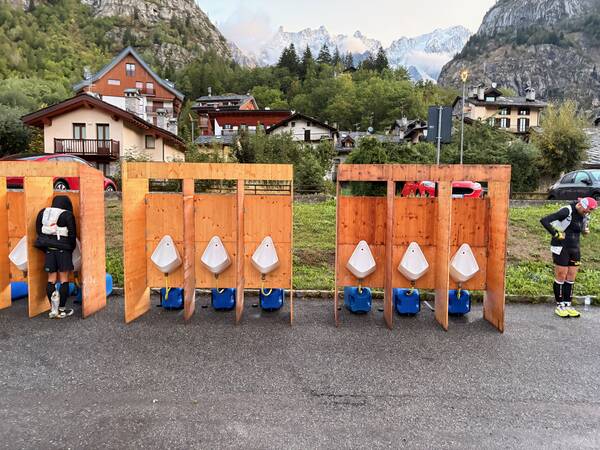
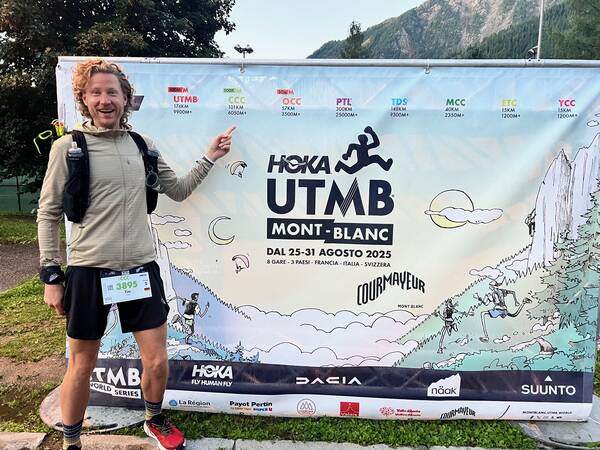
I think it’s one of the very cool aspects of this race that you get to run through three different countries and there are no border controls.
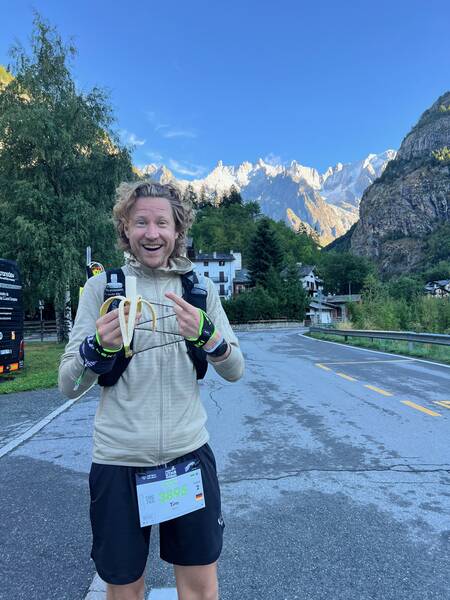
The Courmayeur Sports Center is used as a place for us to stay and wait until the time to race finally arrives. It’s about two more hours until the gun will go at 9:00 AM. The Center is great, though. It doubles as one of the major aid stations for the long UTMB race, runners of that race will start coming through here in about 22 hours from now after having already completed around 80 kilometers (50mi). They start their race this evening. Incredible to think that they will then have to run nearly the whole CCC after that.
We have the opportunity to buy a fresh espresso and croissant, both of very high quality, which I do. In the main area of the center, there are even mats to lie down on. A couple hundred of us sneak into the partly hidden large room and use the opportunity to get some rest before the big dance, but some volunteers make it clear this isn’t allowed. Shortly after Sophie and I entered, the doors were barricaded. Lucky us!
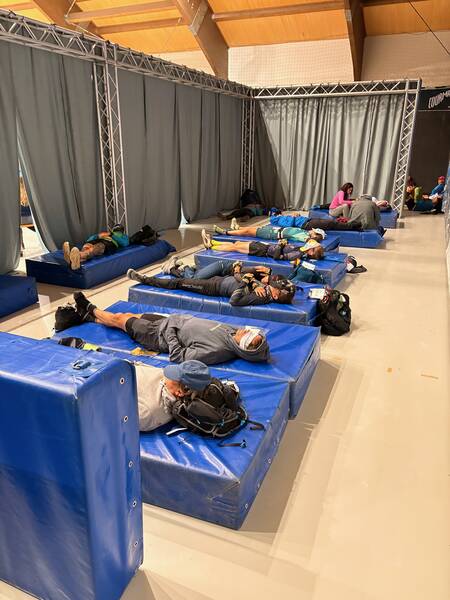
The eerie atmosphere and quietness of the big amount of people adds to the feeling. I start to really get into the excitement and nervousness I love so much before these big races.
With about twenty minutes to spare we all decide it’s time to walk over to the starting line. I expected it to be around the corner, but it turns out those twenty minutes were barely enough to make it in time. Fortunately, I now learned that the spacing between starting waves will be fifteen minutes. I’m in wave (they call it “VAGUE” in French) number 2 of 3, which gives me a welcome buffer. People are getting anxious now, but it seems to work out for everyone.
The sun has come out, it’s a clear blue sky and I’m very happy about that sighting, contradicting the weather predictions. Temperature is nice here as well, on the cold side at 2-5C (35-40F) but I’ve got my Merino layers and feel good.
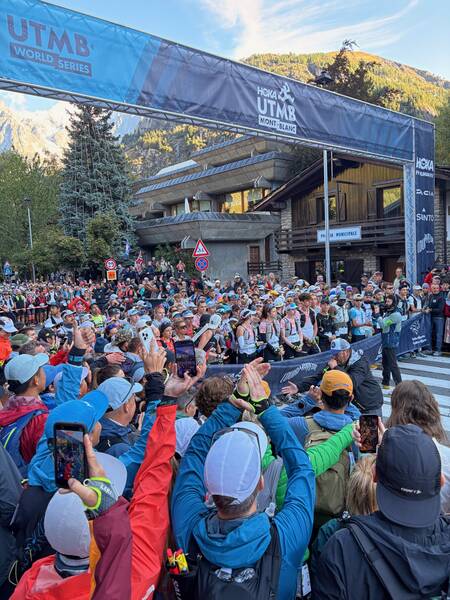
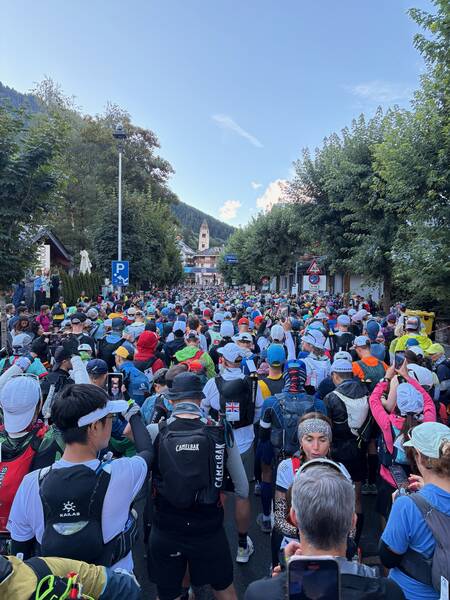
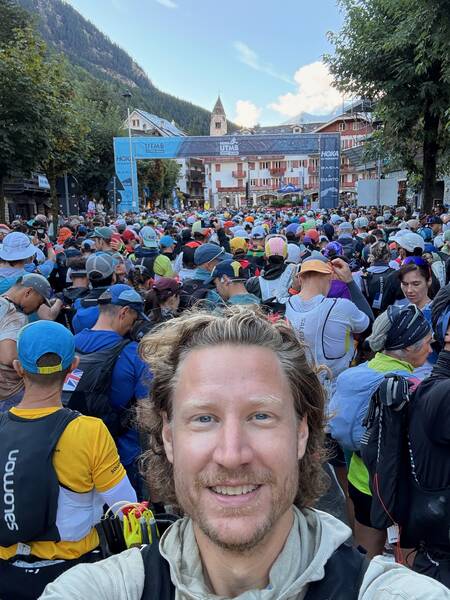
They play some great music and hype us up in both French and English. And they do a good job! The overused Vangelis song is probably reserved for the long UTMB, so we don’t have to hear it here today. I receive a bunch of texts of encouragement and cheering from home. Friends are ready and watch the my live tracking. That feels really nice. They all know it’s about to start.
🔫 And then, it does. At 9:15 AM, I cross the starting line.
Woah. This is always just so overwhelming. All the preparation is done, it’s finally go-time, I’ve got my gear, have put the work in during the past months, now it’s time to celebrate that. To make it through the one hundred mountainous kilometers in one piece, preferably without any major issues but definitely with some difficulties because those can’t be avoided in these long races. The crowds are huge, smiling faces everywhere, I see Sophie taking a video of me and waving from the crowds. And so it begins.
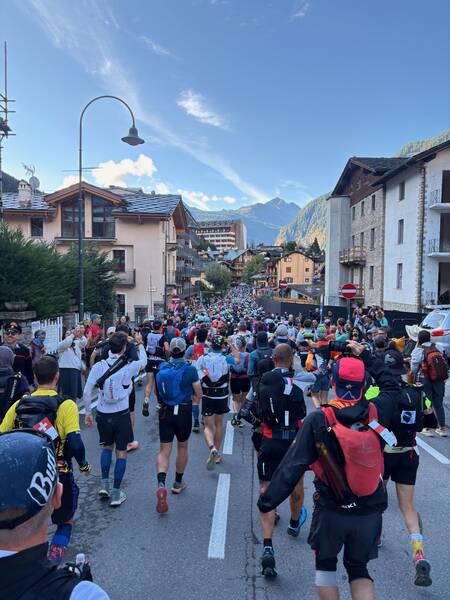
🔥 LET’S DO THIS!!!
It’s moments like these where I’m reminded of just how lucky I am to be able to make it to an event like this. Not from a financial point of view, although that’s certainly also part of it, but mostly from a physical one. I am a fit and healthy 41-year-old, able to run through mountains for hours on end. No cancer, no injuries, no accidents, no real hardships of any kind basically. That’s just super lucky and whenever these races are getting tough, I remind myself of that. How thankful I am that I get to do this. That my body still works and my legs carry me. It’s a huge privilege that’s unfortunately impossible to share. But at times, it’s okay to just celebrate with yourself for a while. The outcome of the race is decided in our heads and I’m keen on spending the next hours in mine and explore – both my mind and the world.
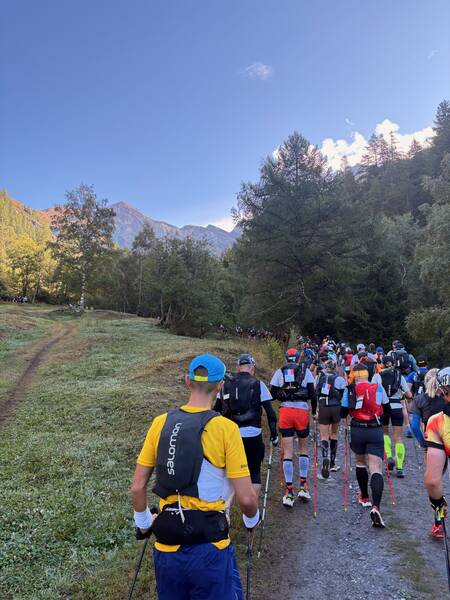
The first few hundred meters are flat but then it immediately gets serious. This is not going to be a walk in the park, that’s for sure. I had the elevation profile printed out hanging on my wall for the past few months just to get the general impression of it into my head, and my basic understanding at this point was that the two biggest climbs will happen during the first half. Once I’m at Champex-Lac aid station after about 56 kilometers, it’ll get a lot easier.

Not so fast, amateur!
That was a huge miscalculation on my part.
Although it can go a long way to have a mental image of the task and break down a race this long into several parts to make it seem more digestible, here I’ll recommend using a different approach to mine. You need to be aware of how tough the course in the latter half of the race will be. On paper, the climbs don’t reach as high anymore, yes, but they are incredibly hard. And the later downhills are, in the words of one of the livestream race commentators, just going to be “disgusting”.
📝 Talking Race Strategy
Fortunately, the negative impact this mistake had on my race wasn’t huge. And that’s because of a strategy I have applied ever since my big fail at 2022’s Templiers race: Don’t start too far at the front of the field.
You won’t ever hit the perfect starting position and it’s far better to start too far back.
Here, I was in the second starting wave of three, which is already good. With about 2,100 starters, this is also the biggest ultra trail race I have ever been a part of. I had no idea how the fitness level of the runners here were, but quite high, I had to assume. Given they all had to collect a bunch of Running Stones at other difficult races such as I did, I’m positive I have never been at a race with such a density of accomplished ultra trail runners.
It’s not that I haven’t made any progress in the meantime as well. My Tuscany Crossing finish from April was quite alright – I placed 40th out of 172 male finishers after over 100 kilometers. But still I chose to be careful and positioned myself in the last few rows of this second wave. This strategy has lots of advantages and one downside, but that downside is an advantage in disguise.
With a field this huge, traffic jams can’t be avoided. People have warned me about this and described it as being cause to much frustration. Pushing a couple thousand runners through a twenty centimeter wide single trail just takes time. No one can really be passed, so those of us who aren’t great at the climbs will inevitably block the faster ones. I think my strength is in the uphills, because that’s just about raw power instead of the elusive downhill technique which I can’t really practice in my home region, but it’s super difficult not to over-pace on these first uphills. Adrenaline is high, our bodies are tapered and ready to go, and the atmosphere and views do their part. How can you resist the temptation to run up that first mountain fast, forgetting for a while what’s about to come after it?
Which is why my tactics of starting further behind are great. Yes, you will get blocked by slower runners, but that will make you save much needed energy in the long run, no pun intended.
Granted, that first full stop after around five kilometers did cost a handful of minutes, but because I anticipated it, I wasn’t annoyed. That seemed to be the case for the others around me, too. Everyone was on their best behavior. It’s funny how people like us are running our own race against ourselves but it will still be affected by all the others around us quite a bit.
↗️ That First Huge Climb
The long queue of runners is slowly moving up the mountain. We’re going from an elevation of 1,220 meters (4,000 ft) at Courmayeur to 2,540 meters (8,300ft) at “Tête de la Tronche” in just ten kilometers (6mi). That’s a gain of over 1,300 meters (4,000ft) basically all in one go. I arrived there after spending 2:22 hours snaking my way up with all the others. It’s hard and sweat is pouring down, no question, but the amazing views and the knowledge that a good chunk of all the total elevation gain is now done immediately pay it back.
I was feeling slightly dizzy at times, trying to figure out if it’s because of the blocked inner ear or the thinning air up this high, or the general discomfort of the sickness still in me. When I looked at my heart rate and found it to be at just about 150 bpm, thinking it felt more like 170, it added to the confusion. It was clear my body wasn’t at 100%, doesn’t matter what the cause for it is. But what can you do except to listen carefully to the signs and try to keep going? We have to work with what we get.
👂 Beating the Ear Drum
My right inner ear wasn’t able to adjust to the changes in air pressure, and that became painful. The funny bit is that I found out during all the later ups and downs that the sweet spot for my ear is at around 1,900 meters (6,000ft). That’s where the pressure is exactly as my inner ear likes it. It became my built-in indicator for the current elevation. Whenever I noticed the pain coming back I looked at the watch again and it confirmed our elevation had moved away from that sweet spot area. New body sensor unlocked. Hooray, I guess?
But in general I was doing fine. The legs moved, the heart rate is sort of okay, my lungs open and working, not much coughing. Time for the first big downhill – my nemesis. Every region I have done these races in turned out to feature big differences in the downhills. So I was curious now to get a feel for what’s to come. This downhill wasn’t easy for me and many people passed me between the two checkpoints – the one at the mountain top and the one after this downhill, ending in the first aid station. The tracking claims that 61 people found the segment easier than me and flew down past me. I have such huge respect for how seemingly fearlessly they did so.
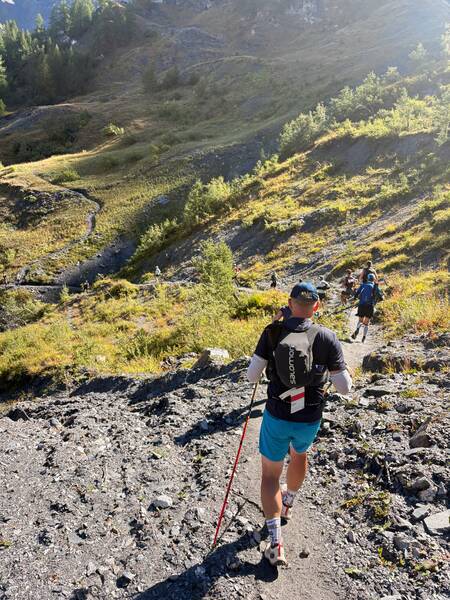
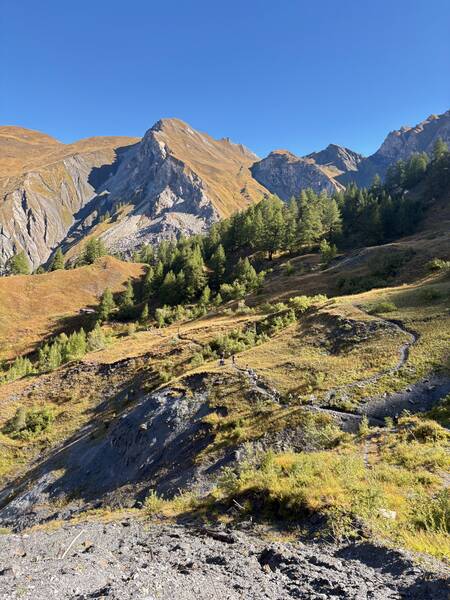
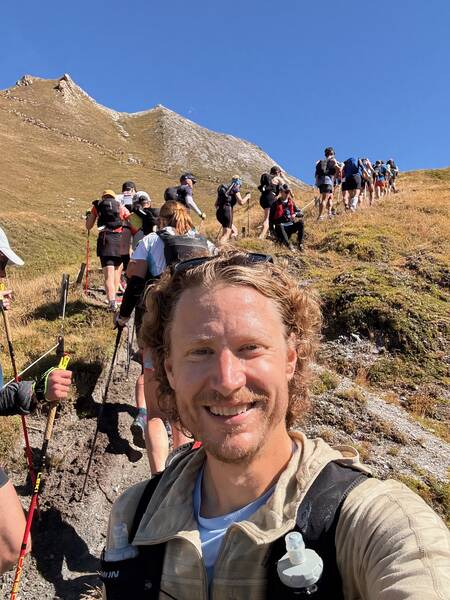
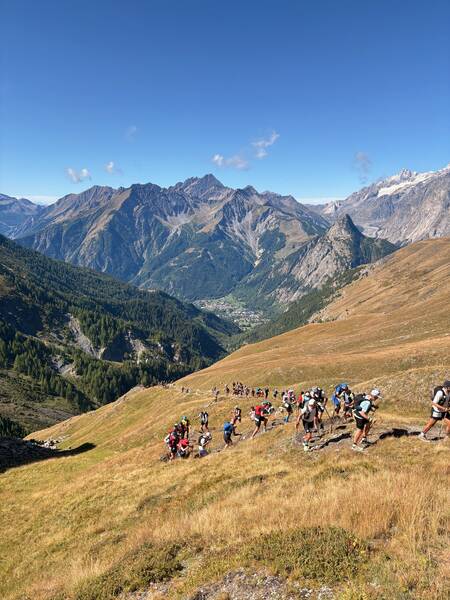
I had a shocking tumble right at the beginning and was just able to catch myself at a high speed just before I would have fallen, so I became even more careful and opted to let more people pass me. The downhill wasn’t on single trail anymore, so passing was fortunately quite easily doable.
🍭 The UTMB/CCC Aid Station Verdict
The first aid station at Refuge Bertone, 14 kilometers (8.5mi) into the race, was a welcome sight after about three hours of moving through the mountains. I felt kind of fresh, thanks to my many long runs, but my bottles were empty and a short breather to take a look at the scenery wouldn’t hurt.
I was also excited to find out about the aid station quality at this race. For me, that’s one of the main measures of how great a race is, and of its worthiness of the entry fee. And I must say, UTMB did deliver. This aid station, and all the others coming up, left close to nothing to be desired. Only two small tweaks I’d suggest, and I mentioned them in the post-race questionnaire too.
They had a huge selection of food and drinks, super friendly and helpful volunteers, and all the items had bilingual signs in English and French, showing their nutritional content and allergens. There was sweet and salty food, there was coffee and women’s hygiene kits, and all the usual basics were here as well.
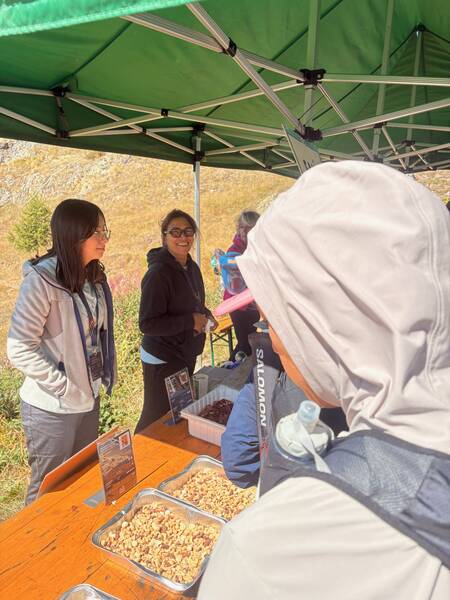
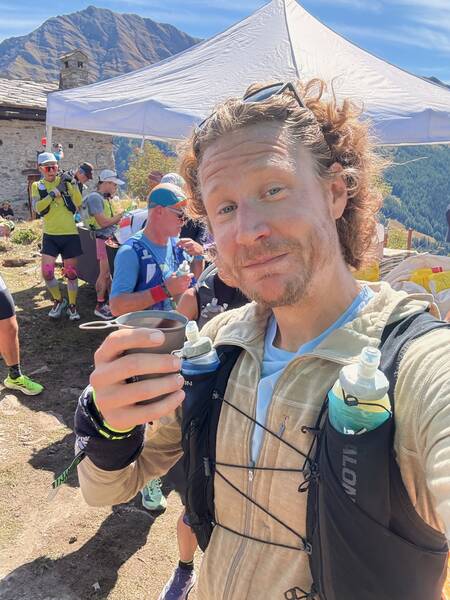
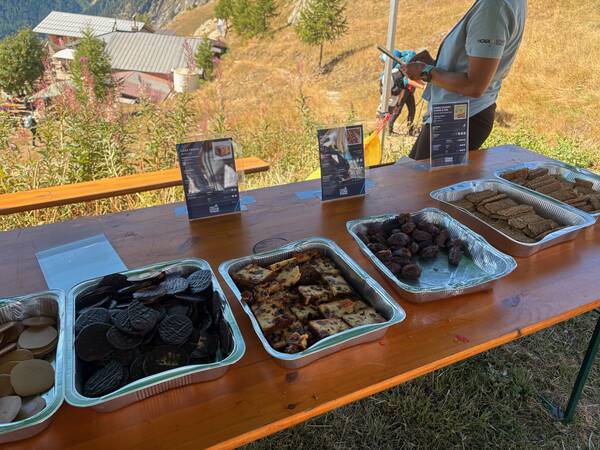
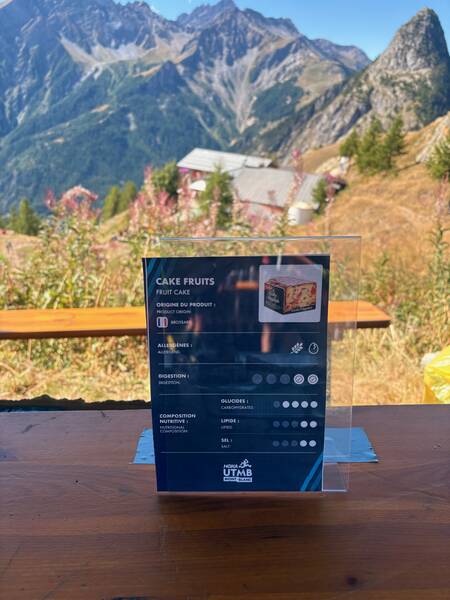
I refilled one bottle with water and one with an energy drink mix they provided, made by the Canadian brand näak. My two small complaints include that energy drink. It’s not that it tastes bad, that’s alright. They had two tastes on offer, lime and watermelon. Here I chose lime, and it was just so sour! Like taking a bite out of a whole lemon with every sip! When I later switched to watermelon, that problem was solved. The mix has a good amount of carbs and electrolytes, which is great, but the company also prides itself on including 8g of protein per serving, claiming that giving the body the tools to rebuild the used up muscle fibers with proteins during the activity is good for us. I’m not a scientist but I felt gastric distress and I suspect the energy mix formula to be the cause. During running ultras, I usually feel changes in nutrition altering my bodily state after half an hour and here that seemed to have a clear connection. Processing all the additional protein must have given my gut too much extra work.
I knew näak from the Lavaredo Ultra Trail and wasn’t a fan of it at that time either. A bit of looking around online seemed to confirm I wasn’t the only one experiencing this and attesting it to the drink mix containing protein. So, as UTMB I’d rethink the partnership with näak and replace them with a more traditional energy mix. Something with sugar and electrolytes in a well-balanced way should do the trick – no need to go fancy here. The other näak products, mainly calorie-dense waffles and energy bars, were absolutely fine though. I liked those and ate a bunch.
🌳 Taking Care of the Environment
The second tiny complaint involves the cola drink they were offering. Cola of some sort is an important part of any aid station. In an effort to reduce the footprint on the environment of the whole race, they decided against carrying truckloads of plastic bottles of Coke up to the aid stations, but instead just used the sodastream brand cola syrup and filled that with water which they carbonated right there. I saw the huge amount of metal CO₂ canisters needed for the carbonation at the aid stations and was wondering if that really made such a difference. But I hope someone did the math and it does. Still, as much as I appreciate an effort to reduce the environmental impact, the main problem with UTMB is that it makes people from all over the world fly over here for the race, me included. The CO₂e those flights emit must be the biggest contributor to the damage done by far. And that can’t really be avoided yet, unfortunately. This leaves the bad taste of greenwashing in my mouth when I saw the sodastream solution. You can argue that every effort counts, no matter how small, and I’m agreeing with you there. But my problem with this particular solution here was also the density of the drink. When using sodastream cola syrup and making it according to the recommended instructions as I’m sure they did, it only has 4.4g of carbs per 100 milliliters. Some artificial sweeteners are added. And I don’t know about the caffeine and phosphoric acid content, which has this calming effect on the stomach. Real Coke has 10.4g of carbs, more than double. And we do really need the carbs during this race, that’s for sure! So did they maybe hurt the race more than they helped with this method?
It did taste great and refreshing, for what it’s worth. Many words, tiny complaint.
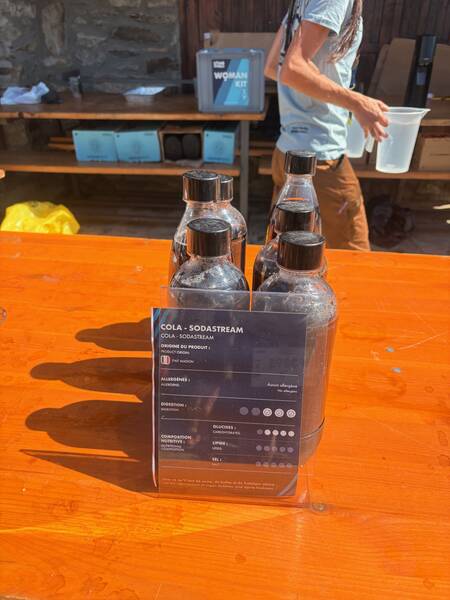
To be fair, UTMB has done a few more things in the environmental area. You saw the wooden toilette solution earlier, for example. They also made it easy to buy offsets for the CO₂ emissions caused by every athlete participating, including their means of traveling and travel distance. For me, that came down to 7.45 euros and the calculator for that was integrated into the entry fee payment process. And what I liked as well was the partnership with the French rail system: UTMB participants got a special discount for the high-speed TGV train trip from Paris into Chamonix. It was very affordable and I hope people made use of it. But it’s just not feasible for people from Chile or Australia, of course. Even for us, it would have taken two full travel days per direction.
🥁 Finding My Rhythm
After around twenty kilometers, I was getting into a groove. Finally, the first big uphill and downhill were over and some real running possible. The traffic congestion slowly became less problematic and everyone was more or less able to run according to their own abilities instead of those of the person in front.
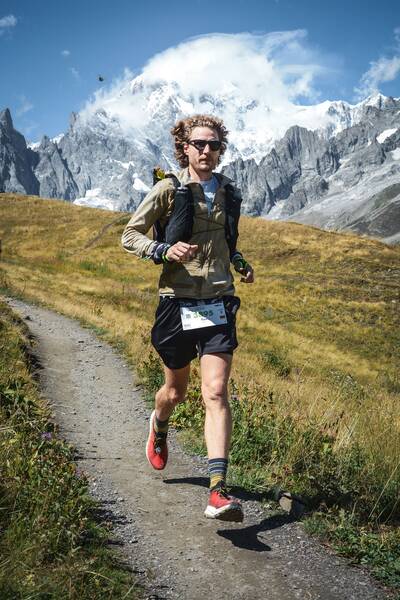
I also started feeling like I now had a grasp of the style of technicality of this specific race, thinking it won’t change that much. Spoiler: I was wrong. But I didn’t know that yet and was on a high. Smiling on the trails, sun in my face, amazing mountain views ahead, feeling alright and not affected too much by the symptoms of my little sickness. In fact, the sore throat, snotty nose, and even the inflamed inner ear seemed to improve over the course of these first hours. It’s amazing what a bit of racing adrenaline can do.
This could work!
It’s cold up here in the mountains and also windy, but my Merino long sleeve still became too warm at some point during the midday heat of the sun, so I continued in a shirt.
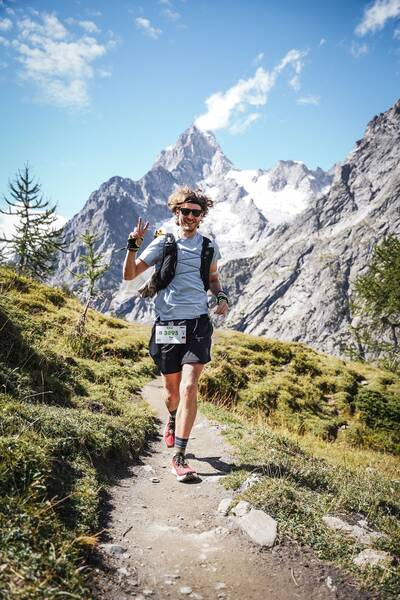
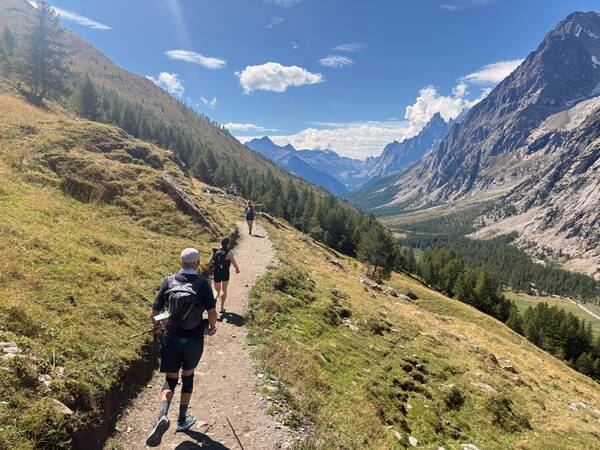
The next aid station at KM 26 (Mile 16) was great as well and followed by a mostly runnable downhill. At Arnouvaz they didn’t offer sodastream cola but had an interesting setup with a type of bar tap option. You put your foldable cup underneath a double-outlet and pull a lever to cause that to pump carbonated water and cola syrup into it. Like a DIY version of what you would get at a professional soda machine. It worked quite well and was fun to use, too!
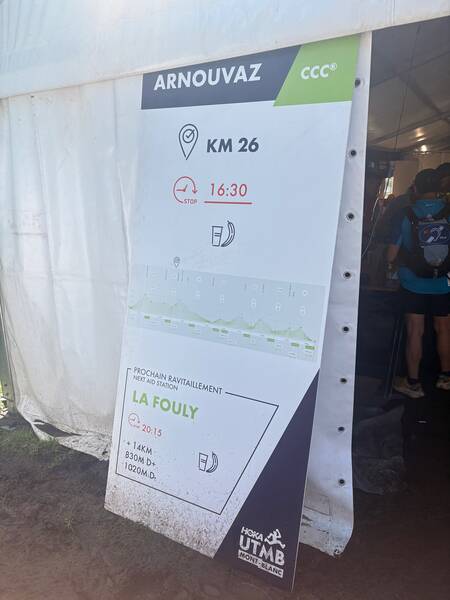
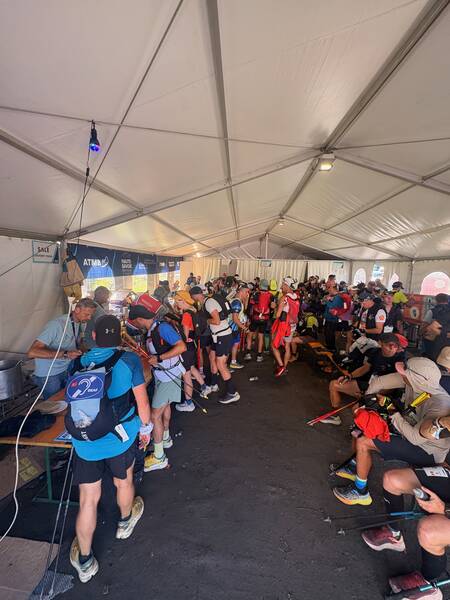
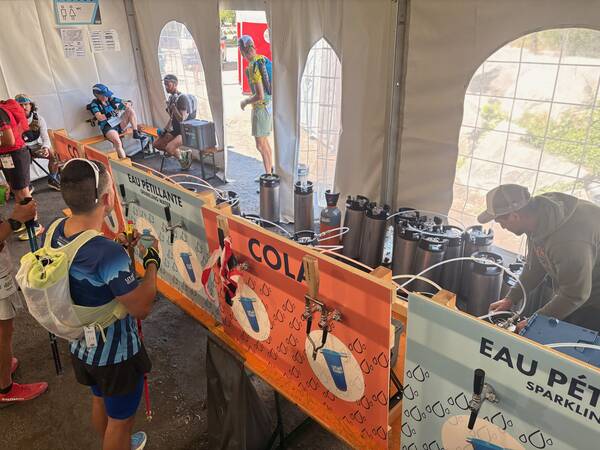
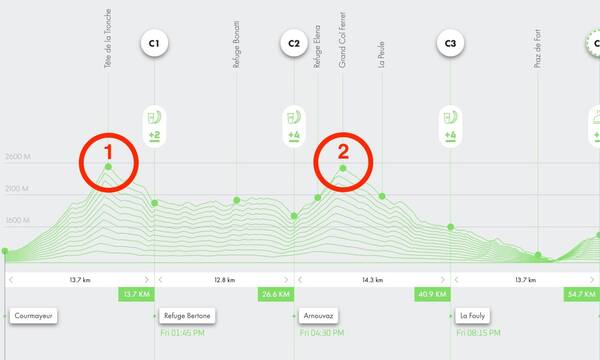
Now, the second big peak came up. It took a while to get up there, the main kilometers of the climb had a grade of around twenty percent on average. Sections of it were even steeper. The peak, Grand Col Ferret, was slightly higher than the first one, this time we got close to 2,600 meters (8,500ft). Super windy, but sort of warm with the sun shining. The Col is about 32 kilometers (20mi) into the race and marks the border crossing into Switzerland. I reached it after 6:10 hours.
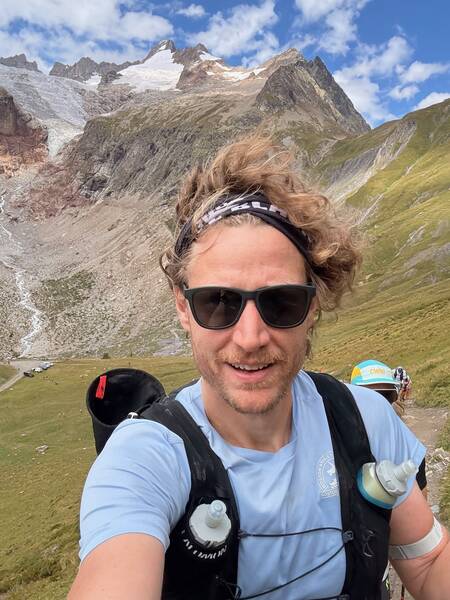
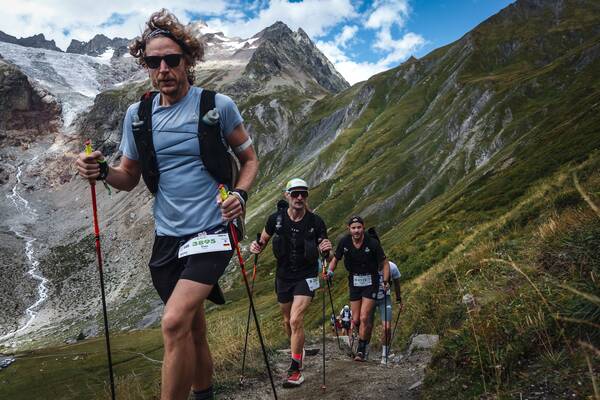
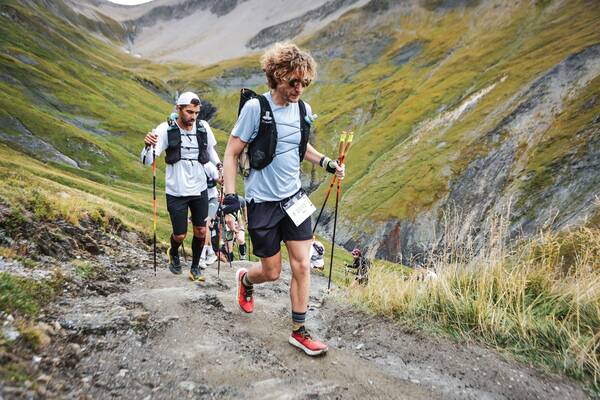
The downhill was very runnable for me, I even had my fastest kilometer of the race during it, kilometer 41 was done after 5:16 minutes (a bit over 8 minutes/mi). Super fun section!
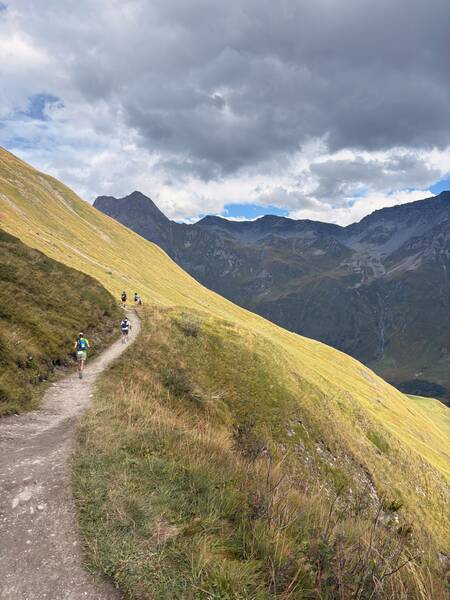
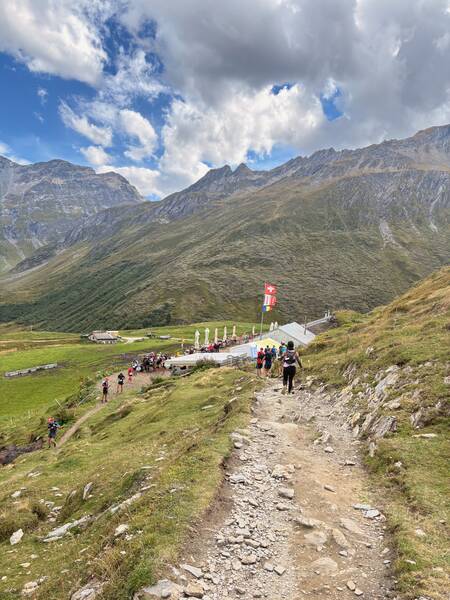
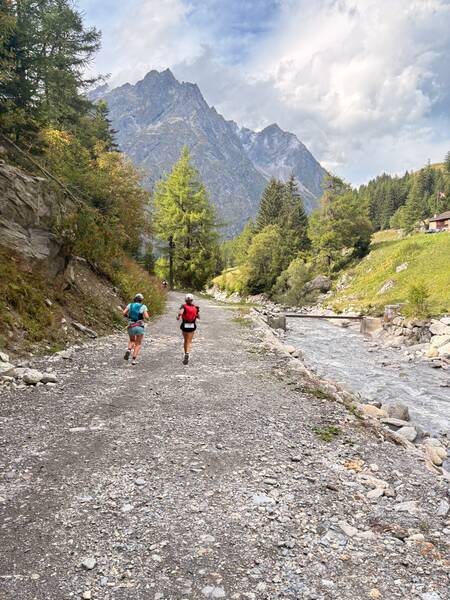
🇨🇭 Switzerland, La Fouly Aid Station, I Got This!
Just for good measure, I had some hot vegetable broth with rice in it to celebrate reaching the marathon point of 42.195 kilometers (26.2mi) no one here cares about. I do, though! It’s still a magical number to me. I give the volunteers here a big thumbs up and receive grateful smiles in return. So cool they gift us their time today. It’s also easy to practice proper pronunciation of the basic words “Merci” and “Bonjour”. Melody and inflection in the voice matters!
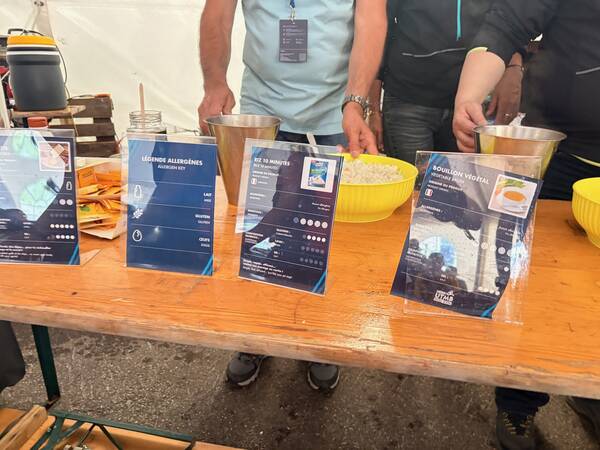
I am on a high from having completed the two highest peaks including their respective downhills. Everything in my body holds up. My MNSTRY gels still taste great and seem to work – I eat one for about every hour. The watermelon näak drink is kind of okay, I’m getting used to it and my stomach slowly seems to, as well. I do still sometimes feel hungry, so I guess I could have gone with even more carbs.
🚫 Don’t Look Down, Don’t Look Up
While it’s not that hard to stay on the trail for now and the views keep being amazing, there are a lot of sections which look dangerous to me. We’re running counter-clockwise around the Mont Blanc massif, meaning the side of the mountains most often goes down on the right side of us and up on the left side. Sometimes I look down to the right just to immediately internally go “ohhh crap, better don’t trip now.” So I vow to not look down as much anymore, calming my nerves.
On the other hand, on the climbs you can sometimes see the switchbacks the other runners in front are on so far up to the top it seems frightening, too, but in a different way. It’s demotivating to see how long the upcoming climb will be. So looking up is to be taken with a grain of salt as well. Best just to look ahead instead! One step at a time.
This next bit to Champex-Lac aid station is mostly easy to run compared to what came before, I knew that. There’s even some asphalt included and we can make real progress there. The houses have changed and look a lot more like we’re in Switzerland now and I’m just rolling through.
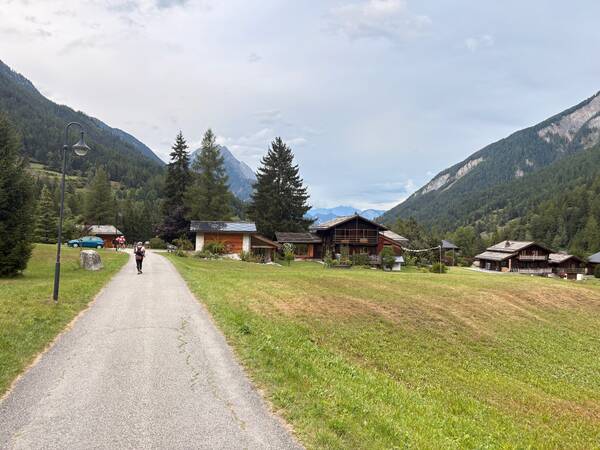
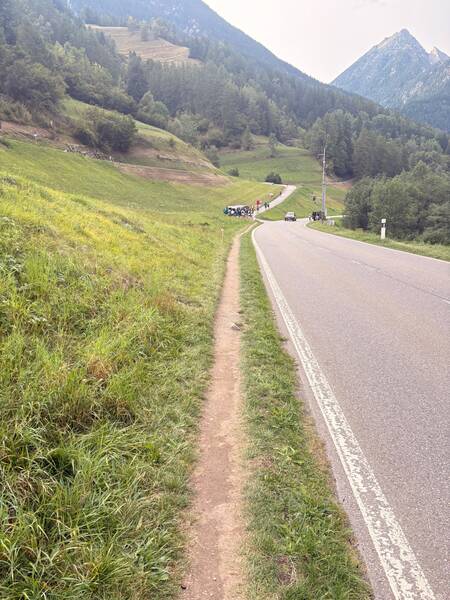
I’m on a huge high here. Eating up kilometers as if it’s nothing, full of energy!
Some people are cheering here, too. That’s a rare sight so far, because the mountain trails have been so remote. We’re crossing actual villages now. I really like that part.
There’s a short uphill section coming up where we gain around 300 vertical meters (1,000ft), making it to over half of the total elevation to be climbed, over 3,100 meters (10,000ft) now. With the total kilometers crossing into the 50’s, it’s now basically just about running home! Next up is the aid station I knew so well from the UTMB livestreams of the previous years.
🌊 Champex-Lac, Crew Support
Coming into town the crowds really start to add up here. I see smiling faces everywhere and I can’t help but smile continuously. Such a cool race! Some are visibly surprised by my smiling and waving, my guess is that’s because most runners look like they’ve just done over fifty kilometers in the Alps. I’m just so happy to be here though and the gratefulness overpowers the tired legs.
This famous fourth aid station, situated after about 56 kilometers (35mi), is the first one that allows crew support for all runners. Crew members have to buy tickets for it in advance, which I did for Sophie. This includes transport to the aid stations with shuttle buses which go here from Chamonix every thirty minutes at peak hours. The whole trip to Champex took one and a half hours for her. She was content with it, brought her book and followed the live tracking using the LiveTrail app we runners were recommended to activate to see how far away I was at all times.
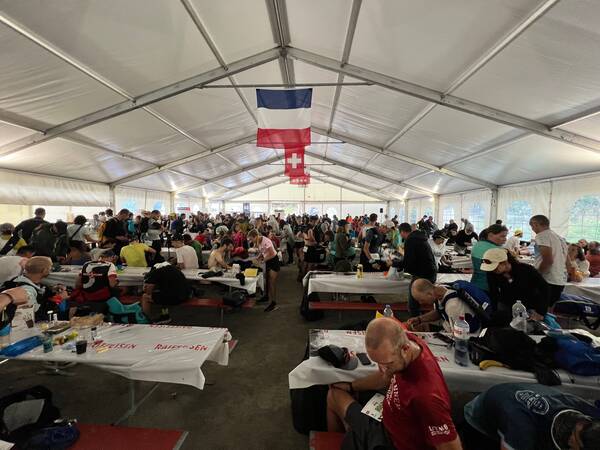
For me, this was another huge highlight of the race: Having Sophie here with me, crewing my long ultra trail race for the first time ever, she made me feel like a king. She welcomed me with big smiles, hugs and kisses, and had all the gear I packed ready on a spot at the table, asking me what I needed. I told her I was doing really well, which I was, arriving here after just 9:22 hours. Before the start, to give her a vague idea, I had calculated that 10 hours should be realistic, but I was even faster – another reason to be happy.
Going over my things here, I chose to switch one pair of my double socks to a thicker one. A fresh and dry pair that’s even more gentle on the sore feet does improve well-being. Sophie brought me some veggie broth with rice in it and refilled my two flasks. One with water, one with watermelon näak. This gave me some time to take care of the socks. I also put eight more gels into my backpack because I ate the other eight I had with me. Those eight alone add up to 1,280 calories, really making a positive difference in this calorie-intensive day. Two saltstick pills, the first and last ones of today, round up the picture and replenish some more of the lost electrolytes. I enjoy the warm broth while Sophie rubs some Pferdesalbe on my calves, a herbal cooling gel made for sore muscles. Feels so good!
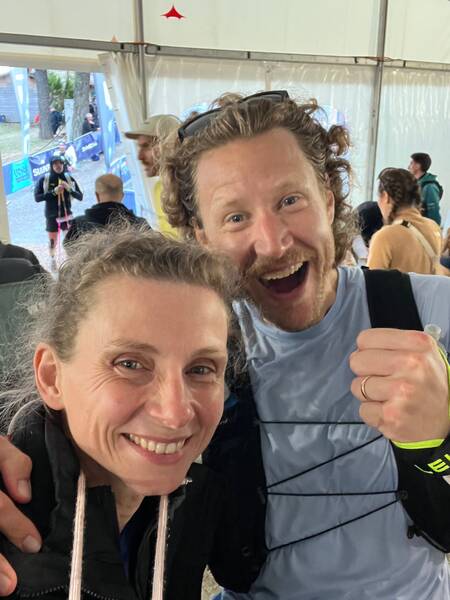
📊 Talking Strategy, Does Mine Work?
I take a quick look at the phone and see plenty of messages from friends who are following the live tracking. Apparently I’m doing really well moving through the field! My strategy worked out perfectly again so far, I’d say. While on the first downhill I lost 61 positions, between all the following segments I passed by a lot more people than passed me. From the first aid station to the second one I gained 95 positions, then up to the second peak Col Ferret I passed 125 people even, down to La Fouly another 39, and on the recent flatter bits towards this place, Champex-Lac, a record 135 positions. Seems like I’m on fire! That’s the motivating effect that starting towards the end of the field has.
Looking at my expected finishing time is another motivating factor. Before starting the race, I had estimated that around twenty hours might work out for me on this course. That is, before knowing anything about the feel and difficulty of it. Sure, I’ve seen it on the livestreams, but running on it myself it turned out to be completely different to what I imagined. It’s funny, but it’s really tough for me to recognize any parts except for the significant lake that’s coming right after the Champex-Lac aid station. My own prediction of my finishing time of twenty hours is therefore quite arbitrary and could be off by many hours in both directions. Still, it gave me a boost seeing that now that I have done a good bit over half of the race, leaving the aid station after 9:30 hours seems to give me a realistic chance at going sub-twenty.

Still riding that high, I kiss Sophie goodbye after thanking her twenty times, and make my way to the famous lake.
🫠 And That’s When It All Went Downhill
The beauty of ultra running. You can never know what will happen and you’ll go through all the emotions over the course of a long race, sometimes even at the same time.
It took a while though for my positive vibes to become really dampened. The first thing was the rain. Right next to the lake, it first started.

No problem, I thought. I’ve got my gear, running in the rain is fine. I’ve had ten dry hours of running already and I’m thankful for that. I put the new Merino long sleeve with the hood back on, feeling great in it, but a bit later I chose to do it as the other runners and also added my mandatory waterproof jacket on top. A few minutes later, the rain stopped for now, so off with the jacket again. That’s just nature, no problem, moving on.
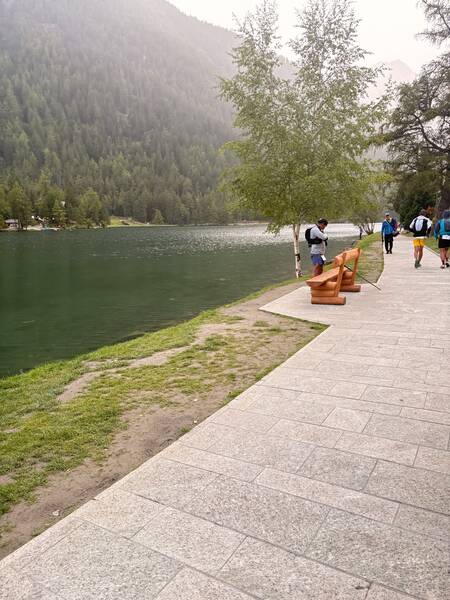
This next section between aid stations is a tough one. A long 16 kilometers (10mi) one, I think the longest stretch without help, and including 1,000 meters (3,300ft) of climbing as well as a 1,200 meter (4,000ft) descent. That’s some serious stuff, costing a lot of time.
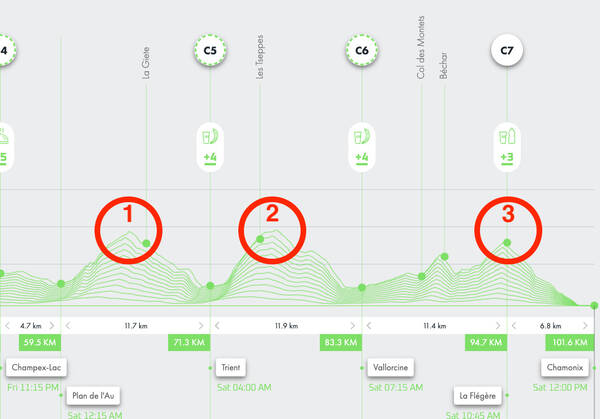
The climb is alright, nothing too technical or steep, but not very runnable for me either. For the steepest kilometer I needed 18 minutes, the rest was somewhere between 8 and 14 minutes. Now is the time the day ends – the sun has given us enough for now. It says goodbye by showing us some breathtaking views of the Swiss town of Martigny. When I stop to take a picture, a runner passes me, looks at the view and says in Spanish: “SPECTACULARRR.”
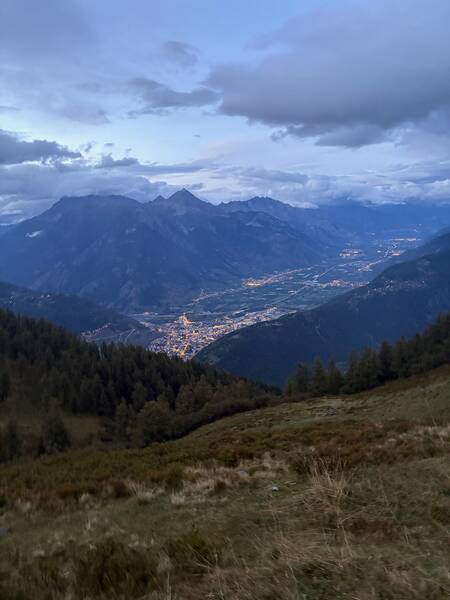
🌇 The Sun Going Down
Shortly thereafter it’s time to bring out the headlamp to be able to see anything.
I’ve said it before, running in the dark isn’t a problem for me – living in the North basically means most of my winter runs are dark – it’s just that it seems to be such a waste to run through these amazingly beautiful regions while only being able to see a small illuminated circle of a path right in front of me. But I get it, there’s no other way for a long race like this one is. I’d just have to be a lot faster and arrive at the finish line before sunset like the elite runners do, so that’s on me I guess!
It dampens my mood though. The mountain views are a huge motivator and now they’re gone for good.
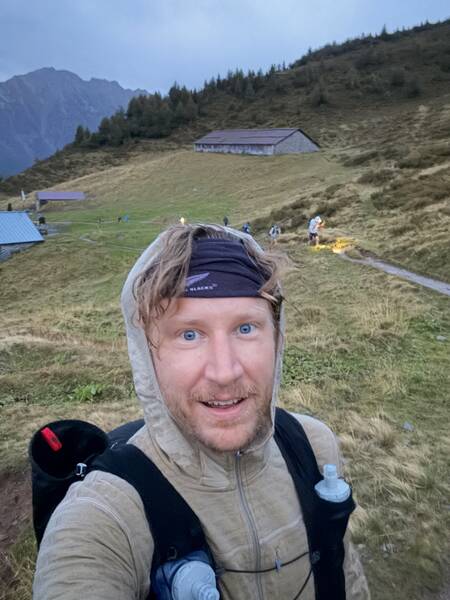
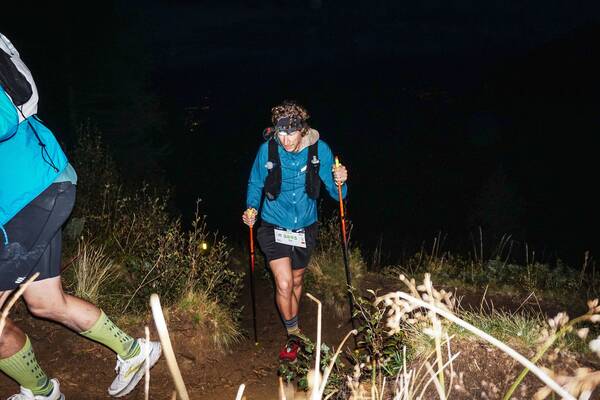
There’s a mini aid station called La Giète shortly after the peak, which by the way is at about 2,050 meters (6,700ft) above zero. The aid station is inside a tiny stable, possibly formerly used for chickens or something because its ceiling is so low I have to walk bent over.
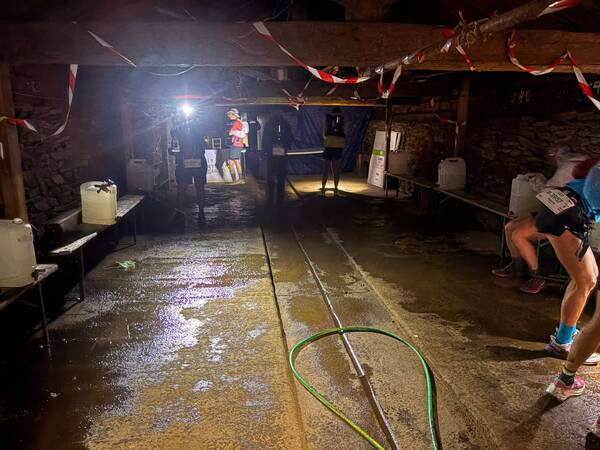
There’s water and näak electrolytes available and two teenage girls are volunteering here, listening to pop music in the dark. It’s also a checkpoint station and the girls wield a big electronic apparatus which is capable of scanning the chips attached to our bib numbers and uploading the timestamps to some place on the internet so people can confirm I’ve been here. But, they don’t seem to understand that it only works with proper proximity and half-ass the thing when scanning me. Sophie later told me that she and my friends following along on the live tracker feared the worst when my position just wouldn’t update as expected. Did he fall and get injured? Give up? What has happened?!
Fortunately all that turned out to be okay and retroactively the staff was able to figure out a rough time estimate of when I (and probably many others) actually passed that tiny aid station. According to the tracking, I passed another 132 people since Champex-Lac – probably because many people chose to spend a lot of time at the big crew-support aid station and my stop was efficient and short. I didn’t feel very fast on this uphill and don’t remember passing that many people.
Here in La Giète, a few other runners had sat down and in their faces I could see the fun having clearly faded away. They all shared the sentiment that we’re on the tougher half of the course and that it won’t get any easier. The rain had also started to fall again so we were wearing our waterproof jackets.
The long downhill is just five more kilometers, but it seems like forever. The rain has made parts of it muddy and slippery. Somewhere here there’s one of the special sign posts warning of a herd of cattle coming up, and it doesn’t lie, there are about 30-40 cows just standing here, blocking the trail, looking very confused about the runners trying to go by. I take a wider detour through the deep mud while others just mingle with the cows fearlessly, looking for a shortcut. My shoes still hold up even in the deep squishy mud, it’s all still dry inside – great engineering by La Sportiva. Very happy about that.
The rain and wind do make it super cold now, though. And while my core is still warm, my hands have turned numb. This is something I didn’t realize because it happened so gradually and then all of a sudden. Good thing I bought the new waterproof gloves yesterday. I have another pair in the pack, but that one is just warm and not waterproof, so I happily get out the new ones. Half an hour later the hands are perfectly warm again, too warm in fact. Back into the vest they go.
🩲 Mr. Speedo, Party Boy Sighting
I don’t remember where exactly, it might have been a few hours before, but there was a guy actually running this serious and long race just wearing a speedo and singlet. What the…? I mean, there are lots of people wearing the wildest costumes at other races, but at something as tough as the CCC? Where I just almost froze my fingers off? The audacity!
I had to laugh and tell him that’s a great outfit. Turns out he was German. Very few Germans here today, I wonder why. Lots of French, obviously, but the country flag tags we all got at the bib pick-up and which many people chose to wear were from all over the world. I noticed a big number of Chinese people, both women and men, some Thai and other Eastern Asian ones, and also many different South American countries were represented: Chile, Argentina, Brazil. A bunch from the UK and the United States, and of course most of the Western European countries, notably many tough Belgian folks. In general it all seemed to be well-mixed, but of course with a heavy focus on the so-called First World Countries. This niche of our running sport can be an expensive hobby if you choose to do it this way.
Bathing suit guy was apparently fine in the cold weather with his ultralight outfit. He looked very strong for an ultra runner and probably had the natural bulk to keep him warm. He also had the aura needed to pull that outfit off. Kudos. But for now, I was faster than him.
🚾 A Make-shift Toilette Break by Two French Guys
Another curiosity I came across was during an easy downhill on a smooth trail that was a bit wider, maybe around a meter and a half, making it easy to pass people. The two in front were talking in French to each other, nothing unusual so far. I was just about ten meters behind but getting closer and ready to overtake, when one of them suddenly said to the other something that I understood to mean “Oh no, I need a toilette break right now, you have to help me, here, hold my arms so I don’t fall!” – he then pulled his pants down right there on the trail and squatted. No time to choose a more private spot, it was one of those sections where it goes down steep on both sides: Left side up, right side down.
The friend seemed to comply and helped the one in need relieve himself. Right before that started, I passed them and made sure not to look back. No need to see this! And since he had help, I figured it was alright.
I’ve heard so many stories of people having digestive issues on long races like these and I don’t envy them at all. I’m super glad that for me it’s only ever been slight discomfort at times, possibly caused by näak drinks. For the next race that offers only that product, I’ll definitely consider bringing my own mix.
I don’t remember the downhill towards Trient to be very tough, but my split times hovered around the ten minute per kilometer mark, so it wasn’t easy rolling either.
🍜 Trient Aid Station, 73 Kilometers Down, Crew Access
Coming into Trient aid station, the struggles were instantly forgotten because Sophie was waiting there for me. This is the second aid station that allowed crew access and I was looking forward to it. At the time I was still making relatively solid progress and wasn’t too depleted in my motivation to continue, but the downwards trend had certainly started. It’s just a part of ultra running.
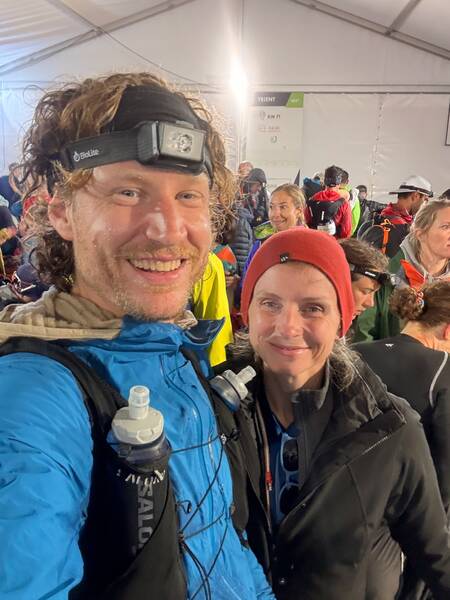
From the elevation profile of the whole CCC I had hanging on my wall at home for months I remembered the second half to consist mainly of three distinct peaks. All of them looked like they were going to up to around 2,000 meters (6,500ft) and down again to the base line. This made it a bit easier to digest, because right now, the first of the three was checked off.

Also, the total elevation climbed and descended crossed the two-thirds mark, and with the distance at nearly three quarters, I was happy to have completed so much of it already. With a total time of 12:42 hours so far my chances of beating twenty hours still looked great – that’s about one full hour to spare should I be able to continue with the average pace I had up until now.
Chatting with Sophie here was really good. There was a party atmosphere and the offerings for crews were quite good, too. Food and drinks for them to buy and pass the time until that hectic few minutes when they would be needed by their runners. Sophie again helped me refill the flasks and brought me some broth with noodles in it. We chatted for a bit and I asked her about her day so far. Lots of bus riding! She said the announcer here at Trient had access to the names of the runners coming in from the tracker and said “And now here comes Tim Teege from Deutschland! Tim from Deutschland!” That’s nice, especially when coming from a French guy.
Sophie again put some Pferdesalbe on my calves to cool the strained muscles and it felt great. She asked me if I needed anything else, maybe something special the aid stations don’t offer, for when she meets me at the next one at Vallorcine. I answered, a real Coke would be great. With the correct amount of sugar and actual caffeine. So cool to have that option now that I have a crew at a race!
↗️↘️ Trient to Vallorcine
I do not remember how I made it through that bit – the second 2,000 meter (6,500ft) peak of the three ones in the second half of the race. For sure, it was a fight that happened in a blur because my brain just said “enough!” and switched off all parts which questioned what I was doing here. The rain stayed with us, the mud as well, the uphill was really steep and I had some of my slowest kilometers here. The downhill was difficult, too. I witnessed quite a few falls as well, but nothing serious, fortunately. I myself slipped just once and landed on my butt on a muddy downhill, but also took no damage from it.
The cursing of the runners around me in all the different languages confirmed the difficulty of the section. The most prominent word I’ve heard uttered in a multitude of accents was the F-Word, though. I’m not the cursing kind of guy, but I have this other habit when I’m exhausted. I make a sort of horse’s noise with my lips flapping. That definitely increased on this section! By now I was also sure my two big toenails where about to turn black again, having just barely recovered from the last ultra race I did four months ago. They were hurting and hot. No point in having a look now, though. That’s for after the task is done.
My tracking and the official UTMB tracking don’t align perfectly here, but this section is about 13 kilometers (8mi) long, has 900 meters (3,000ft) of climbing and also roughly of descending to offer, and it took me a whopping three whole hours to make it through. That tells you how cooked I was at that point. By now it’s 1 o’clock in the morning. Everything is cold and wet and I’m tired.
🥾 Is this even a running race? Or maybe more of a hike?
In the ultra running scene it’s an ongoing meme to self-deprecatingly label these races as “fun little hikes”. There’s a popular Instagram meme account which made caps with a ‘POWER HIKER’ print on them and gave them out during the expo in Chamonix.
I get some people don’t like to hear the races they trained years to accomplish be reduced to this and definitely disrespected in that way, but I personally think that’s pretty funny and I’m sad I missed out on one of those POWER HIKER caps.
But addressing the sentiment, yes, a lot of the CCC can only be hiked, and even the elite do so. And looking at the long UTMB, that’s even more prevalent. The idea still remains the same, though: We all try to make it through the course in as little time as possible, and sometimes that just has to include hiking. The fitter you are, the less of it.
This year’s UTMB winner, Tom Evans, who did the 175 kilometers in 19:39 hours, stated in a post-race interview that he felt he just out-hiked everyone else this time, not jokingly. Meaning, being a great hiker is the key to success in this particular terrain. This is interesting, because he’s also a fast beast on flat asphalt and many coaches currently think one of the keys to winning ultra races is being the fastest one of the field in the shorter distances. Surely it’s a combination of both. And every time I suffer through these later parts of ultra races reduced to being a hiker, I vow to get better at it. I think over the years I have improved a lot by these defeats – it’s funny how there are again two sides to the story: Defeat and success happen at the same time.
The big aid station at Vallorcine gets closer and that’s a great relief. I long for another break but also to make it to the finish line fast. I remember this place to be one of the major party zones during the livestreams, mainly because the elite runners get through here during midday and it’s often sunny. Now, way past midnight, in the rain, the crowds are a lot smaller than what I’ve seen. But some tough crowds are here, wearing waterproof gear and holding umbrellas. I first have trouble finding the entrance to the big tent. The course is leading around the tent first. Inside, it’s nice and dry as I fall into Sophie’s arms.
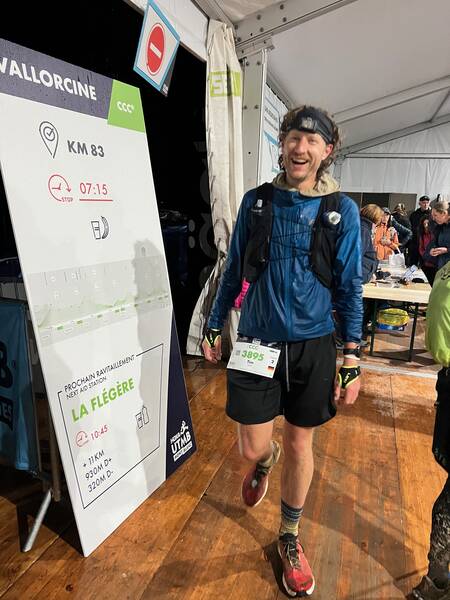
🥱 Vallorcine
Meeting Sophie here again is another big boost. I don’t talk much now anymore because of the tiredness but I’m very happy to see her. She has managed to find that real coca-cola for me and also got a hot cup of tea ready, because everyone is soaking wet and freezing here. I’m not saying no to that although from a warmth perspective I’m doing well.
She told me that Mr. Speedo has just been here – he must have passed me at some point – and finally threw on a jacket. Still wearing the speedos, though. Dude must have Viking genes or something.
The aid station is really big and you can even buy some hot and fresh fries and beers if you’re a spectator, in the middle of the night. I stay here with Sophie for fifteen minutes, a long time. But according to the tracking, that’s right on the average of how much time runners at my level spend here. After 16 hours of running and hiking, six of them in these tough conditions, it can be hard to muster up the motivation for the remaining eighteen kilometers with another peak in it. And the ugly thing is, there’s even one more peak hidden in it. It looks so innocent on the elevation profile, but especially its downhill is super hard and slow. That’s the one before the final ascent to the last aid station called “La Flégère”, but it was actually the bit that made the commentator say it’s “disgusting”.
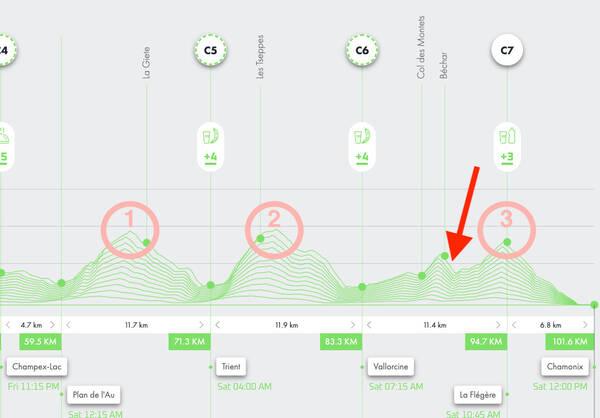
🏂 On to the Last Aid Station, La Flégère
For the last few hours I often had that thought in my head saying “when do I finally get to run again? I want to run please!” because it just wasn’t possible for me during the constant climbs and descents. Now, coming out of Vallorcine, I was super glad there was some running for a few kilometers. A fairly easy ascent that’s still runnable now, having a grade of between just three and six percent. I did these kilometers in an abhorrent pace of 9:00 minutes per kilometer (14:30 min/mile) but even that felt like I was moving fast compared to what was before.
That mentioned hidden peak followed. Both on the 250 vertical meters up and down I needed 20 minutes per kilometer (32:00 min/mi). This is so agonizingly slow, but I just couldn’t change a thing about that. Especially that disgusting downhill, all muddy and slippery, difficult to see, was so stony and riddled with roots I sometimes literally had to stop and think about where to put my foot next. I reached points where I was so decision depleted I just couldn’t find a good spot for the next step. Hesitating, I took a deep breath, made my horse sound, and just went ahead. This happened a bunch of times. I was just so exhausted.
From that hidden peak at 1,700 meters down to 1,450 meters again, the final climb towards La Flégère finally starts.
The first bits of the ascent were tough, too, but it got better. Not faster, but better, because the last kilometer or so is on a ski slope. This is just fine gravel, so I did not need to think about foot placement for a while! I liked it so much better. It was still super steep and took a long time, but the slope was wide and the aid station at the peak in view, so making progress became notable again. At 1,850 meters, the knowledge that this was to be the final climb of the race sort of helps. I still prefer climbs to descents, but getting to check something off is much needed now.
La Flégère is a tiny aid station and I know it well from the livestreams, too. This is where it gets interesting who will win the race because it’s close to the finish line. Just seven more kilometers (4mi) and it’s done.
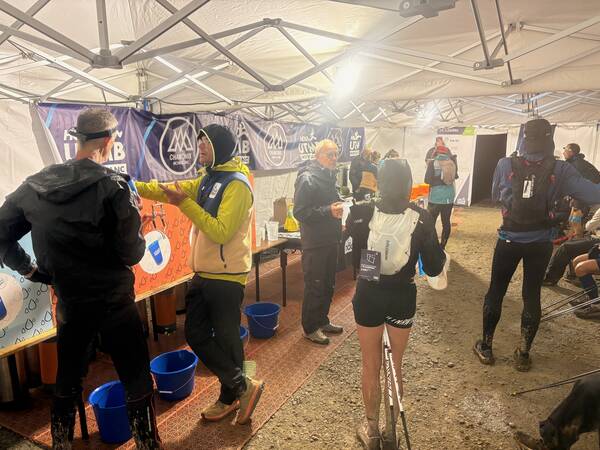
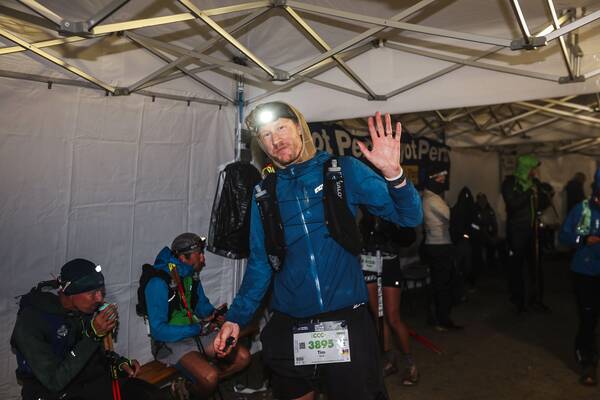
The volunteers here seem tired too, but they’re still very helpful and friendly. A dozen runners sit on the benches, seemingly not doing anything, staring into the void, enjoying that short time with no rain falling on them, trying to somehow gain the energy to get out of the tent, back into the rain again. The faces are empty, it’s 4 AM. I have 1:15h to go to make it in under twenty hours, which sounds plenty, but I don’t know – judging from how long these past thirty kilometers took me, it doesn’t seem possible. And I mentally give up on the goal here, because it would just needlessly jeopardize my life to scramble down as fast as possible in this situation. I can barely concentrate on anything anymore.
🛝 Finally, the Last Downhill
I just spent a handful of minutes at La Flégère, emptying the trash of my gels into the bins, getting some more water into the bottles and having a few cups of the cola mix and a few waffles. This is nice and helps. Sitting down like the others won’t help me, I’m sure, because getting up would be so hard. So I just decide to get going almost right away.
It’s delightful that the final descent begins with another ski slope. Pushing on the brakes with the used-up quads still hurts, but it’s way easier to find secure footing. That’s over soon though, and a classic switchback section follows. This whole downhill is more than 900 meters (3,000ft) of loss. Thankfully, the pain in my ear has long been overpowered by the pain in my legs, arms, neck, lower back, and basically just everywhere. Well, I’m not sure it’s really pain, more like strong discomfort. It’s not like I’m injured in any way. And also, as we know and a bunch of spectator’s signs confirmed, ‘pain’ is just French for ‘bread’.
After the switchbacks are done, I am very happy to witness the moment when my GPS watch hops from 99.9 kilometers over to an even 100. It doesn’t get old. My eighth time crossing over into the three digit territory during a run.
Starting at that point, as we close in on the city, every kilometer gets easier. From 14 minutes to 13, then 10, 9, 8, and in the end I even ran a 6:00 minute per kilometer pace again – and that felt so good! The final bits in the town of Chamonix were such a relief. There’s the famous construction-site style bridge that they erect every year to cross an important road when we come back into town. It’s about two stories high and those stairs are great. Not slippery, not muddy, easy to see. Wonderful. The asphalt of the streets is pure bliss, as well. And then there’s the “DERNIER KM” sign, just one kilometer left. What a feeling!
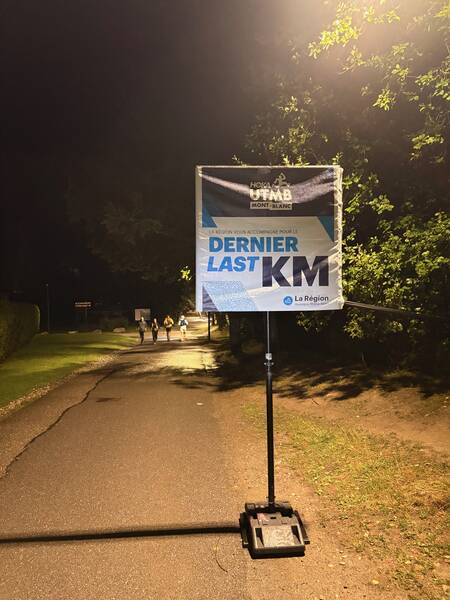
Running next to the famous river, although everything is empty as opposed to when the winners come here. Fair play, it’s past five in the morning. The flower buckets lining the streets are here, though. By the way, by now the long 175 kilometer UTMB race has started and been going on for around eleven hours. The fastest pros have probably already made it past Courmayeur, where I started this race. They still have a lot ahead of them, but I don’t. And it’s definitely enough for today, I feel that in every single bone.
Sophie is here waiting for me in the middle of the night. That alone is just amazing. The final few hundred meters. I’m getting out-sprinted by a guy and his spouse, but I don’t care. That blue arch is all I care about now. It’s super hard to just get the arms up properly for a finisher’s pose but halfway up is enough. Just a few more steps.
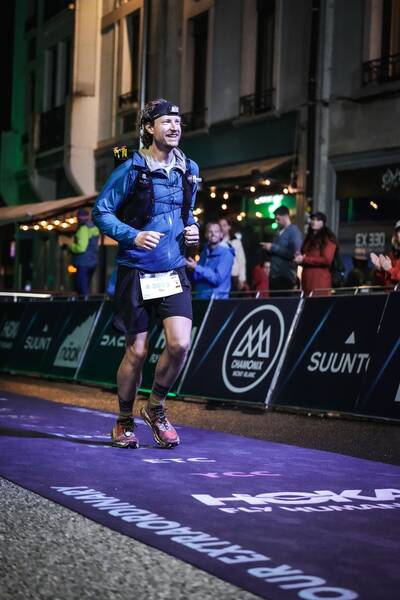
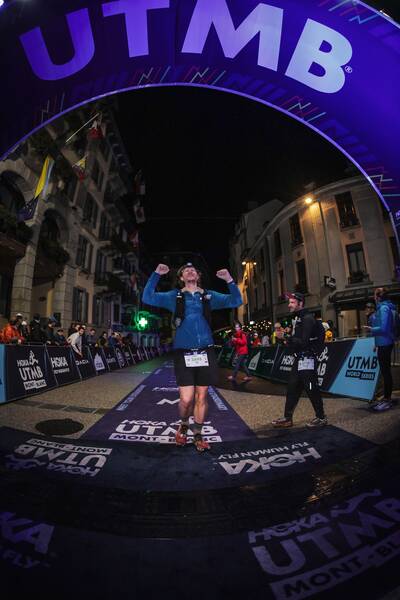
🏁 FINISH! NEVER AGAIN! THIS TIME FOR REAL! I MEAN IT! …or Maybe?
Woah. So good. I fall into Sophie’s arms and she has to support a big chunk of my weight for a while but she’s alright. What a journey! It’s over after 20:11:17, just missed the arbitrary goal by so little, but it’s alright. Safety first.
I think one of the first things I say to her is “boah war das heftig” but it might even have been “boah war das scheiße” – we’re both not so sure anymore. It’s the difference between just “tough” and a hard curse-word. My emotions definitely had the power to use it. Then I said to her that I liked Tuscany Crossing so much more. It’s the same amount of kilometers, it’s also a Western States qualifier, but it was done after thirteen-odd hours instead of twenty, and happened almost completely in the sunshine!
So why in the world would I do this CCC race?!
“No way am I ever signing up for this madness again – least of all the long UTMB. NEVER!”
It’s been the same at Lavaredo and at Zugspitz last year as well. I’ve said this right after finishing. And the amount of time it took for me to fully reverse that sentiment gets shorter and shorter. When posting this CCC activity on Strava, I included in the description that I’ll never go for the long UTMB after now knowing how tough this is, and some of my friends’ comments there already predicted I’d change my mind.
It took one day and I already tried to find out how to most efficiently collect some new Running Stones for the UTMB lottery. Brains are weird.
🌃 What Happened After the Race
Despite all the exhaustion or maybe because of it, I felt proud and happy and relieved and thankful – the positive feelings take over so fast. The best thing was that I got to go through all of it with my wonderful wife Sophie. Seeing her at those three aid stations and now here made all the difference. I’m sure I wouldn’t have DNF’d without her, but it made it all the more fun to periodically see her and share a chat while she helped me restock. It’s a lot to ask of someone to crew such a long race, which is why I didn’t ask her, I just offered it. I would have totally understood it if she’d preferred to stay at the hotel and relax, no hard feelings, but she wanted to be part of it. That makes it even more special to me. Almost right away, she told me about the ways she came up with to make our aid station meet-ups more efficient during the next time. The next time!
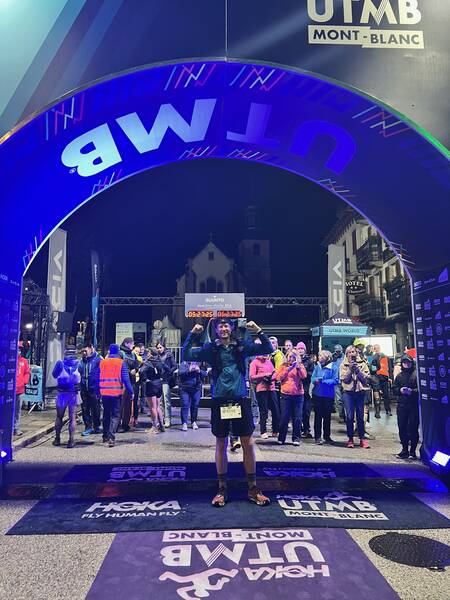
Arm in arm we walk around the finishing area where every few minutes another runner shares the same relief of having completed the CCC. There aren’t a lot of people around, but no surprise there, it’s half past five in the morning.
The CCC doesn’t hand out finisher’s medals, they give me a UTMB and CCC branded blue vest. It looks okay but I’m not sure how often I’ll wear this. The practical rain jackets we got after Lavaredo were the superior choice, in my opinion. But it’s fine, no one does this for the finisher’s gifts.
Walking across the big public viewing area with nearly nobody on it I took a look at the UTMB livestream that was going on there on the big screen. The pros and all the amateurs started the long 175 kilometer loop here in Chamonix at 5:45 PM yesterday. The video looked like the weather was not great. When I later checked out the race reports, it confirmed they had a night of snow and wind and really cold weather to survive before having to deal with the route I just completed. That sounded even harder than the ten hours of rain and mud I just made it through. It’s a tough sport.
Getting into the dry car with its instant heating felt so good. Sophie drove us over to Saint Gervais, where our hotel was located. The half hour went by in a second. Getting rid of the clothes and finding out that my two big toenails were actually fine and all I got as a souvenir was just one little blister was a big relief. The hot shower was pure bliss and falling down into the clean and warm bed even more so.
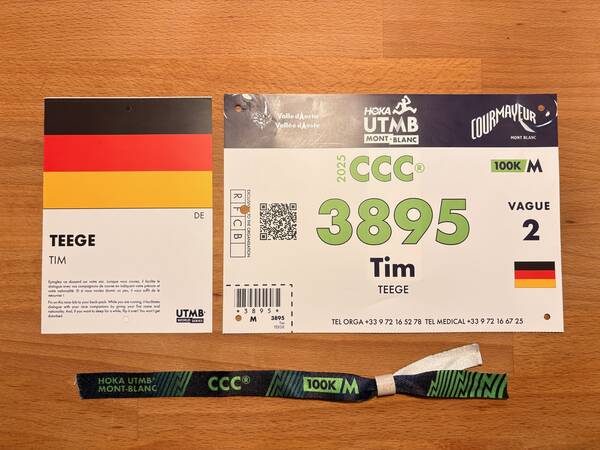
📑 Some Statistics for the Keen Reader
- My GPS watch tracked 104.41 kilometers and 6,099 meters of gain (64.8 miles, 20,000ft) compared to the official stats of 101 kilometers with 6,100 meters
- My official finishing time of 20:11:17 hours put me in 520th place of 1,246 male finishers, which is Top ~42%, solidly in the faster half of a highly competitive field
- Out of the 2,127 starters, 486 chose to abandon the race before the finish (Did Not Finish), so the DNF ratio is at a huge 22.9%
- For this result I received a UTMB Index of 471, which, combined with my previous results puts me at 552, corresponding to the 86th percentile of all male runners registered, or the Top ~15% worldwide (The UTMB Index is calculated from my finishing time relative to the winner’s time, adjusted for course difficulty and conditions)
- I reached the halfway point after 8:37:24 hours, significantly faster than what I needed for the muddy and dark second half (11:33:53)
- My average heart rate was at 132 bpm, 68% of my maximum
- Strava calculated I burned 14,649 calories during those twenty hours – that’s 7.3 large Margherita pizzas, 27 Big Macs, 73 beers (0.5 liters), or 6 kg of gummy bears
- It was my run streak day number 1,337, a cool coincidence because in internet culture that number stands for “elite” – but I’d have had to be twice as fast here to get to be called that
- There’s a way to calculate the “KM-effort” from the distance and elevation combination, and this results in 161.04 kilometers for this race – so next up I think I need to do a 100 miler
- The Climb Score based on the FIETS index for this run is a 10.0 out of 10.0 with 87% of the course considered to be “hilly”
⚖️ The Verdict of the CCC: Should You Apply?
This isn’t a race I can give a simple yes or no to, unlike the Tuscany Crossing which was an easy recommendation. The CCC is more complex. It depends a lot on what you want from an ultra: the spectacle, the UTMB atmosphere, the sense of being part of something legendary – or a quieter, more personal mountain experience.
If someone asked me “Should I run the CCC?” without me knowing their background, I’d probably say: Only if you’re drawn to the UTMB week itself or if you see it as being a stepping stone towards the full UTMB race. In that case, it’s an unforgettable way to experience Chamonix and the hype surrounding it.
That said, if your goal is simply to discover the beauty of the European Alps through running, you’ll find countless other races – often less crowded and more intimate – that can deliver just as much, if not more. I’m happy to have had this experience, but I don’t feel like I want to run the CCC specifically again.
😴 Where to Go From Here? First Step of Recovery: Sleep!
We slept for about three hours, from 7 to 10 AM, in order to not mess up our rhythm. If you fully give in to the tiredness now, you’ll just drag out the problem. It’s just like with a jet-lag.
Today is the day to eat all the carbs. My favorite. Those 14,000 calories I burned according to my activity tracking need to be refilled!
Recently I have come across a little study that found out that not just the day after a race like this counts, even seven days later the body metabolism is still elevated to 1.8-1.9 times its baseline. Meaning, three pizzas on day one post-race won’t cut it. The body needs all the stuff it can get to recover and repair properly. You don’t have to tell me that twice and I managed to do a great job. Recovery week was the smoothest I can remember.
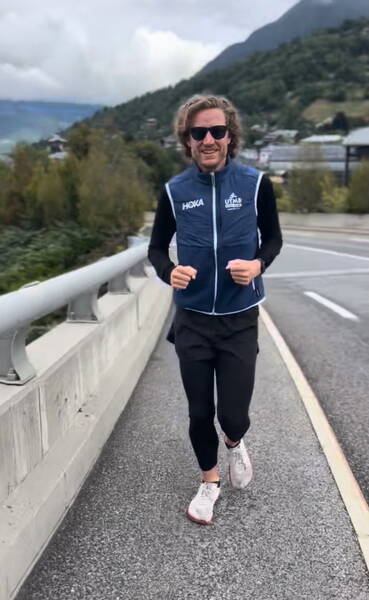
The sore legs were okay after about three days instead of my usual five and so I used the chance to run a short 7.5 kilometer (4.6mi) race near my home on Friday of the recovery week, finishing in 4th place out of a bit over 100 participants. My 4:04 minute average was far from my personal best, but a solid fast time. Two days later, the Flensburg liebt dich Marathon had a ticket for me on offer, and I drove up to run it in 3:21 hours, also not the worst result for me. I attribute this mostly to all the eating I did. I needed a few afternoon naps during the week, but nothing crazy. No delayed tiredness.
So, yeah. The long UTMB is somewhere in my future. It’ll take a few years, but some day I’ll come back to fight my way through that one as well, eating as much as I can along the way.
Bon appétit!
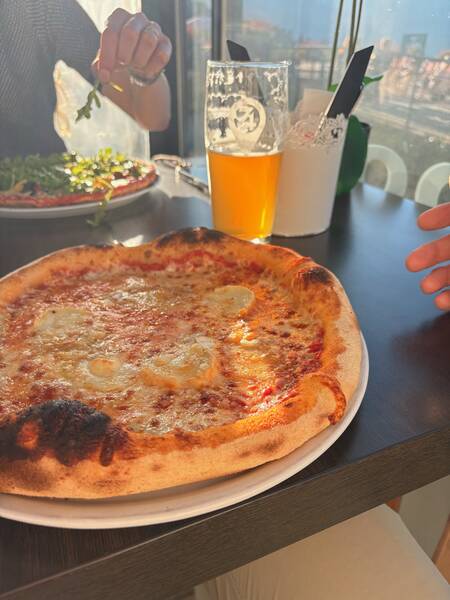
How do you feel after reading this?
This helps me assess the quality of my writing and improve it.
2 Comments
Write a CommentLaurie wrote:
15th of September 10:53
Leave a Reply to Laurie
→Teesche replied:
15th of September 11:16
Leave a Comment